- Oceanis 30.1
- Oceanis 34.1
- Oceanis 37.1
- Oceanis 40.1
- Oceanis 46.1
- Oceanis 51.1
- Oceanis Yacht 54
- Oceanis Yacht 60
- FIGARO BENETEAU 3
- Heritage Sailing Yacht
- Flyer 7 SUNdeck
- Flyer 7 SPACEdeck
- Flyer 8 SUNdeck
- Flyer 8 SPACEdeck
- Flyer 9 SUNdeck
- Flyer 9 SPACEdeck
- Antares 7 Fishing
- Antares 8 Fishing
- ANTARES 11 FLY
- Gran Turismo 32
- Gran Turismo 36
- Gran Turismo 41
- Gran Turismo 45
- Swift Trawler 35
- Swift trawler 41 Sedan
- Swift trawler 41 Fly
- Swift Trawler 48
- Grand Trawler 62
- Heritage Powerboats
- Future Owners
- A REMARKABLE ANNIVERSARY
- Our History
- Our Architects and Designers
- Our philosophy
- Our Innovations
- Your way to ownership
- Event calendar
- Annapolis Sailboat Show
- Fort Lauderdale International Boat Show
- Tests and Awards


Figaro BENETEAU 3
- Description
- Key Features
Specifications
The Figaro BENETEAU 3 is the first production foiling one-design monohull ever created. It is a distillation of technology and innovation, the result of a collaboration between some of BENETEAU’s best experts and the Van Peteghem Lauriot-Prévost (VPLP) office, the architects of the last two boats to win the Vendée Globe.
The prototype has been tested and the production of the boat has been launched. It will enter the ISO/World Sailing design category A.
Naval designer : Van Peteghem – Lauriot Prévost
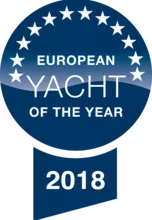
THE ADVENT OF A NEW STANDARD
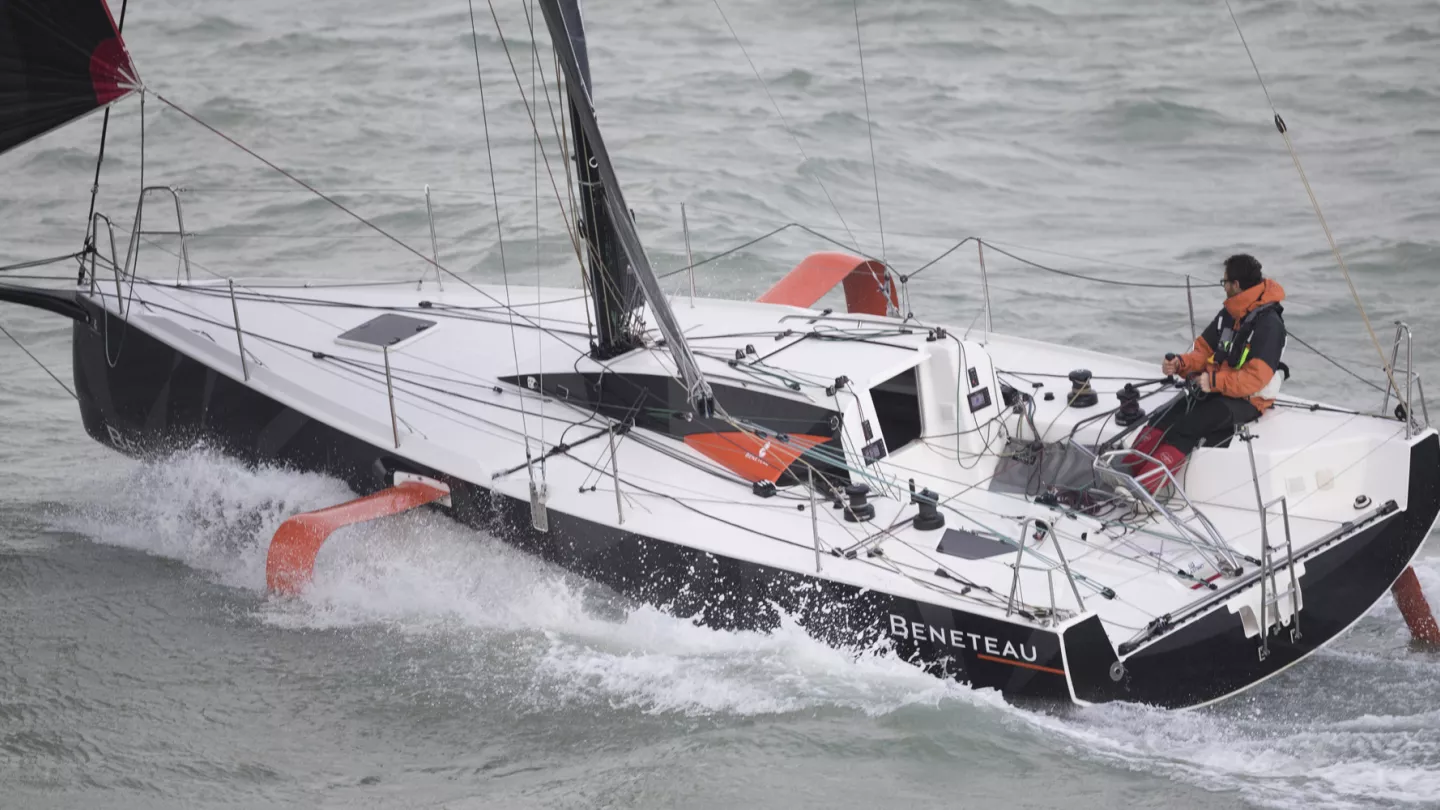
MODERNITY, RELIABILITY AND PERFORMANCE
The specifications define the FB3 monohull as being as reliable as its predecessor, the FB2. It is equipped with foils, a better-performing, ballast-free hull, a more slender and deeper keel, a setback mast and a more extensive, larger sail plan.
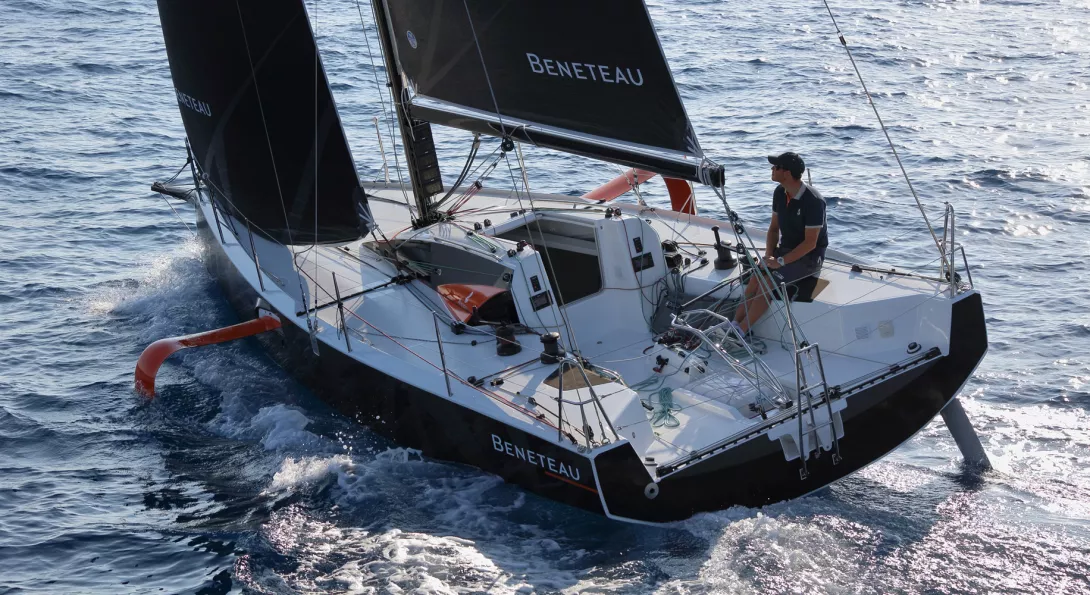
Contrary to Imoca 60 foils, the Figaro BENETEAU 3 foils have an inward-facing profile. The way they operate is different. They are versatile foils that create drift reduction and improve the boat’s righting moment, without increasing the movement, which improves the boat’s performance.
Deep, with a straight blade, it creates minimum drag. Supplementary drift reduction is provided by the foils.
Made of foam sandwich, fibreglass and polyester-infused resin, it corresponds with current designs and is ballast-free.
MAST AND SAIL LAYOUT
Similar to the Imoca 60s, the mast is set back, providing balance under sail. This allows the use of high performance sails and the addition of a bowsprit. Solo sailors will sail with a square-top mainsail, a genoa, and a jib, but also a masthead spinnaker (105 m² (=125 yd²) to gain speed in a light breeze) and a small gennaker.
- Mainsail area: 39.5 m² (420 ft²)
- Jib area: 30.5 m² (323 ft²)
- Large spinnaker area: 105 m² (125 yd²)
Equipped With SEANAPPS
The easiest way to keep your boat safe and ready to cruise anytime.
The new Seanapps app is the ultimate solution to help you indulge your passion for boating. With the touch of your finger, you can easily connect, monitor and order services for your boat – from routine maintenance, to requesting a wash or fuel or having us complete a repair.
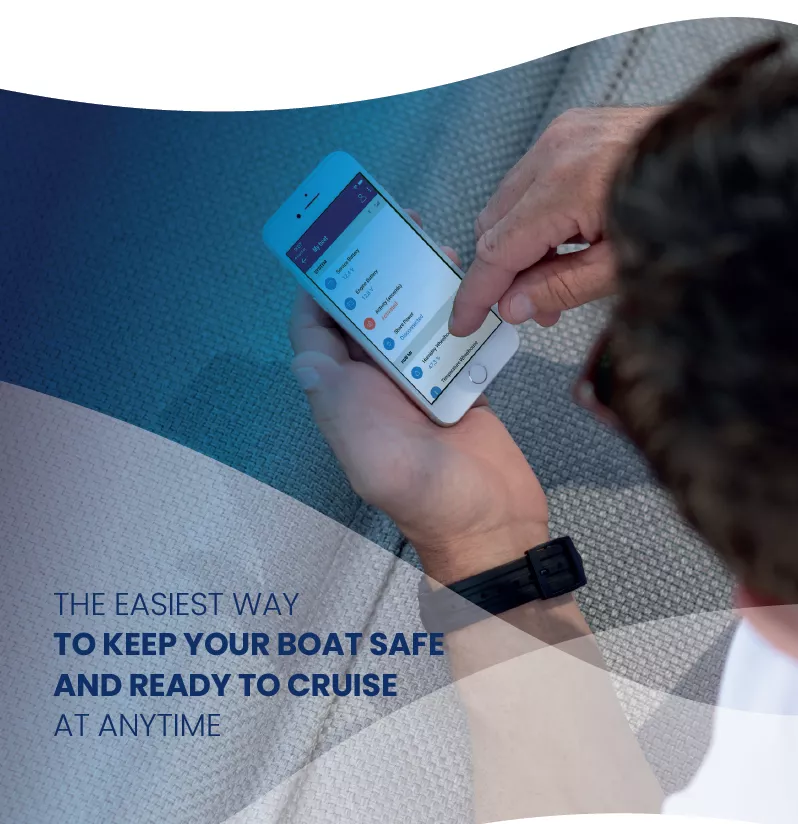
The information below is intended for general informational purposes only and is subject to change without notice and does not constitute a contractual agreement. Any descriptions, representations, or statements made in this document are not to be considered binding unless explicitly stated otherwise in a formal contractual agreement.
Length Overall
Beam overall
Light displacement
Air Draft Max
Fuel Capacity
Max. engine power
CE Certification
A3 / B4 / C6
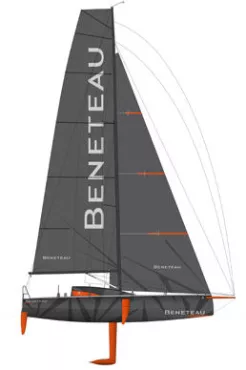
All Figaro news
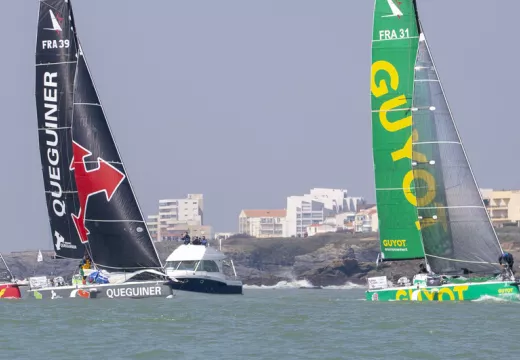
First Sardinha Cup
Victory for Yann Eliès and Samantha Davies
Customer Care
Buying a BENETEAU doesn’t have to be a daunting task. We have teams of experts to guide you through the entire process – everything from sea trials, financing, and customization to after-sale commissioning, service, and maintenance. We are proud to have one of the largest, most highly-regarded dealer networks in the world. We’re ready to provide you with the assistance and expertise needed to launch you and your BENETEAU on a lifetime of happy, rewarding, and memorable voyages.
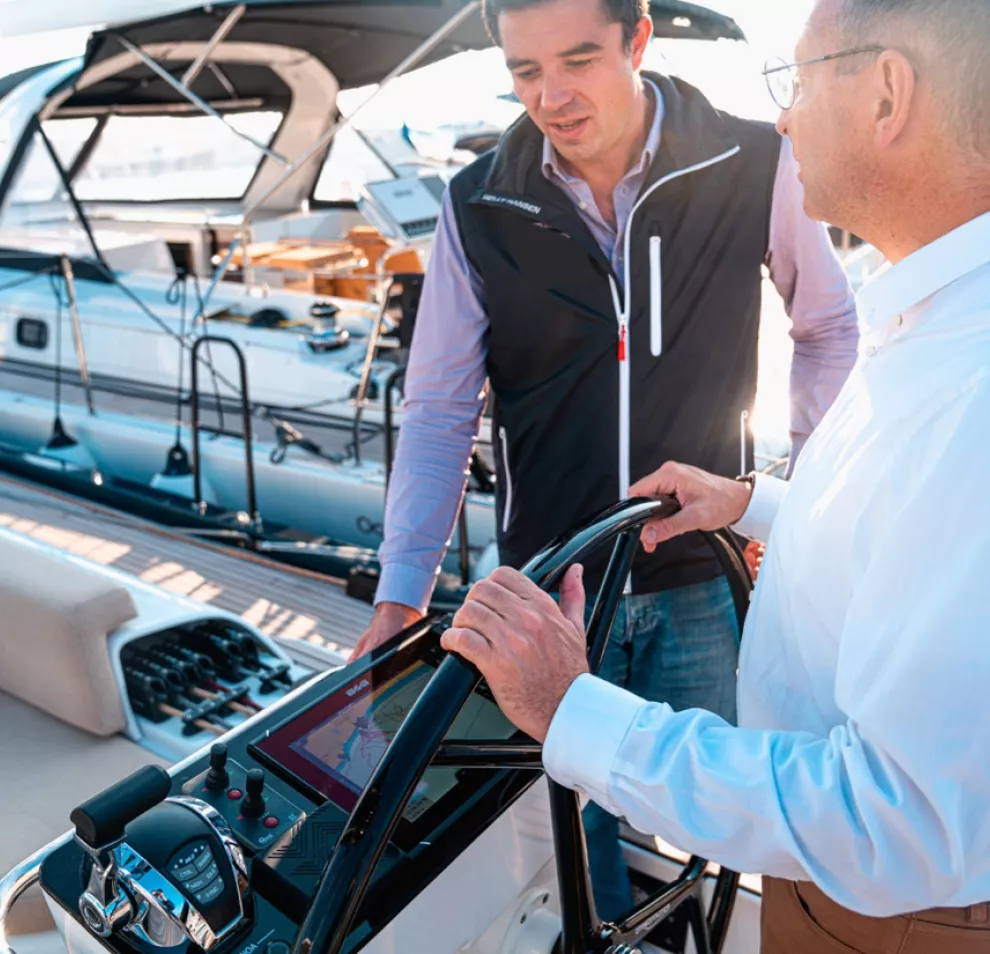
Select your area and your language
- Chinese, Simplified

Persico Fly40, The Foiling Monohull Loaded with America’s Cup Technology

Presented in 2021 by Persico Marine , the Persico Fly40 was designed by Caponnetto Hueber and boasts a unique build team: structural engineering provided by Giovanni Belgrano of Pure and hydraulics by Cariboni, while aerospace-precision construction will be carried out by Persico Marine and its highly specialized team of expert yacht builders. Also involved in the project is Pininfarina , known for its superior design solutions. Engineers and technicians have been studying all the details using the most sophisticated design tools. Safety and one design are two strategic elements of the project: the Persico Fly40 will be equipped with electronic flight control, which will allow all owners to drive the AC75 -derived foiler simply and safely.

Pininfarina’s entry into the design team is further testimony to the value of the project. Daniele Mazzon, chief transportation and yacht designer of Pininfarina Nautical stated: “ It is of great prestige for us but at the same time a natural consequence to work side by side with Persico on the stylistic definition of the Persico Fly40, a boat whose design will reflect functionality, aerodynamics, and performance. The experience gained with Persico over the years will now reach a new dimension where the highest expression of sailing, performance, and innovation meet.
The continuous search for perfect aerodynamics, which is part of Pininfarina’s DNA, has led us to the creation of a boat that flies on water thanks to the total adherence of the sails to the deck and the more developed structure near the cockpit. We are proud to be part of the Persico Fly40 team and to accompany Marcello Persico together with Caponnetto Hueber in the definition of a new high-performance market segment. ”

Persico Fly40: the target
The Persico Fly40 is aimed at yacht owners who are interested in taking part in a high-profile regatta circuit at the helm of a one-design monohull foiler that is derived directly from the experience and technology of the AC75s in last America’s Cup. The Persico Fly40 is a “ flying ” one-design monohull with a speed of over 40 knots. Moreover, it offers a project that goes beyond the individual boat: there will be a chance to take immediate advantage of a dedicated regatta circuit, plus assistance at the most prestigious regatta sites provided directly by Persico Marine. For this reason, specific attention has been given to logistics: the boat has been designed to be disassembled and shipped at a low cost, thus facilitating the organization of the international circuit.

Marcello Persico, president of Persico Marine , commented: “ I am extremely proud of this project, which will bring Persico’s excellence in the nautical sector everywhere in the world. Therefore, I would like to thank each and everyone who is contributing to the realization of the Persico Fly 40 and the yacht owners who are showing great interest. This revolutionary sail/racer has been developed by a team of excellence, including Caponnetto Hueber for naval architecture and hydrodynamics, New Zealander Steve Wilson for the wing mast and rigging, and the world-leading designer Pininfarina. Our company puts its specialized experience in the production of carbon boats at the disposal of sports-loving clients, by ensuring the highest — never-before-seen — precision in one-design construction through the implementation of Coriolis robot-based lamination technology used for aerospace manufacturing. The Persico Fly40 again raises the bar in the building of sport boats bearing our brand name, which attracts commissions from the most competitive sailing teams in the world .”

Persico Fly40 performance
The Persico Fly40 has a minimum foiling take-off speed of 7 knots (true wind speed). The crew members will be the owner and four other sailors to control the mainsail and jib, flight control, and tactics. Additionally, the great safety and ergonomics of the crew positions makes it possible to have a guest aboard, at the discretion of the owner and with the approval of the regatta committee. In light wind conditions, the boat’s systems will also allow for piloting with a crew of only four.
The First Hybrid Electric Nautor’s Swan 88 Launched
Northrop & johnson selected as sales broker for ares yachts’ 62m simena sailing superyacht, royal huisman announces noir, project 411: the world’s tallest sloop, yonca shipyard debuts mishi yachts to capture composite supersail market, live your passion, subscribe to our mailing list.

Published on February 20th, 2017 | by Editor
Foiling in the Monohull Stream
Published on February 20th, 2017 by Editor -->
Something that seemed ‘out there’ just a few years ago is now making its way firmly into the mainstream. It is also winning yacht races. In the March issue of Seahorse magazine , Gordon Kay has an update on DSS state of the art.
With the monohull world increasingly embracing foils it seems timely to reflect on some of the lessons learnt over the past year and how 2017 and beyond look for the impact of DSS and for the other foil solutions in the 2017 marketplace..
While dramatic footage of semi-flying or flying yachts gets the headlines it is the background story that is perhaps more significant. In 15 years of developing, engineering and supplying DSS foils and installing them on various yachts we have never had a failure beyond the cracking of one foil, quickly identified as a failure by the builder to build the hull exit bearing surface as drawn. It is therefore quite thought-provoking to see the failure level in some other avenues of foil development.
The problems suffered by the Imoca class, particularly in testing, have been significant, not limited to foils in the water but to the windward foil as well (echoing issues the big tris experienced when ‘over-stiff’ ama construction led to failures through wave impact on the windward float).

(There have also, in passing, been a great many – unpublicised – foil failures during testing for this year’s 35th America’s Cup. However, this is a different situation where lightweight constructions are consciously being explored and tested to the ultimate limit. Still, it does confirm that this is a complex area of development when the best engineers and designers in yacht racing still have to place more than a little reliance upon good old trial and error.)
Safety and reliability have always been the watchwords in our development of foils at DSS. If it was not going to work reliably or safely then we could not see the point of investing heavily in R&D and practical testing. It will not always be possible to get a client to write endless cheques to cover ‘development’, or if it is then the class will go the way of the Orma 60s and others.
So we stand at a key point in the development of foils within the industry; it is no longer the preserve of the lunatic fringe, and it is crucial that future development needs to prioritise safety and reliability.
Modern history 2016 began with the Welbourn-designed DSS Quant 23 winning its division in the European Yacht of the Year awards. The first fully flying keelboat for production, and designed to be very much the everyman design that would allow a new generation, young and less young, to fly in safety and without the need to swim if it all went wrong.
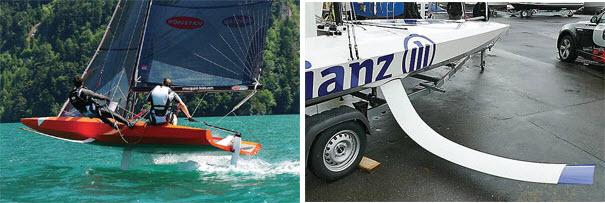
Hugh Welbourn’s flying scow, the Quant 23, uses a curved foil to achieve essentially the same lift effect as is enjoyed on the Infiniti 46 with its straight DSS foils. However, in the case of the Quant the result is full flight in just 8-10kt of breeze. Compared with the Imocas, the Quant benefits from a keel fin to resist leeway, dispensing with the Imoca’s large foil tips. But the similarities, especially between the little foiler and Hugo Boss, are evident. Yet there is still a huge amount to learn, particularly in solving the Imoca puzzle with its rule constraints. Hugo Boss’s 24-hour record was, ultimately, only 2nm better than François Gabart managed four years ago without any foils at all…
To date 10 Quant 23s have been sold, and with the original Q23 now on Lake Garda and available for all to try, more and more people have seen what is available without spending a king’s ransom and requiring America’s Cup levels of skill.
The launch of the Infiniti 46 offshore racer, again Welbourn designed, caused a few raised eyebrows and comments when she first arrived in Europe in May, particularly with respect to the ability of such a boat to sail to its IRC rating.
Class wins and podiums in the Rolex Middle Sea Race and then the RORC Transatlantic Race, all with a Corinthian crew, demonstrate that perhaps the rating office might have been closer to the mark than the armchair experts.
What has been more interesting has been the amount learnt in the 10,000 miles of sailing in 2016 that the first Infiniti 46 has now completed. Zero structural failures, zero foil issues, zero issues with foil exits and, interestingly, zero UFO strikes…
We have always built our foils with Dom Pedron of Isotop and to date they have all been engineered by either Gurit or Will Brooks and, so far, they have all performed to expectation.
An interesting fact taken from the Infiniti 46 is that while the displacement of the yacht is 5,500kg, the foil exits are engineered for 9,500kg of load. Conservative? Probably, but avoiding failure as far as one can through a little extra diligence just seems smarter than saving a gram or two, with the consequential risks, as seen with some of the failures in the Imoca 60 fleet.
Another interesting launch was the prototype FLO1 from Aeronamics. A dinghy that flies but is not a Moth, and as with the Q23 is designed to introduce the averagely capably sailor to an easier and safer flying experience.
As 2016 drew to a close two larger projects emerged. First the CQS, Ludde Ingvall’s inspired reincarnation of his previous yacht, expertly handled by Brett Bakewell-White and launched a few weeks before the Rolex Sydney Hobart Race – making it to the startline against all the odds. That process was bittersweet for us, as the DSS foil itself, built in Vietnam, failed early in the race, having shown glimpses of the performances we have come to expect; with just a few days of sailing with the foil prior to the race there is much to learn. 2017 will no doubt be an interesting year of development for this team, with an all-new boat also in the air…
Finally, we completed our collaboration with Farr Yacht Design on the creation of a new 40m+ fast-cruiser that is now under construction. The process of due diligence took over six months with exhaustive studies of various foil geometries – necessarily in conjunction with different interior layouts. Details are still under wraps but we expect this yacht to demonstrate the same strong performance relative to its conventional peers as the Infiniti 46.
In terms of market appeal, according to our clients not everyone prefers the final designs from a previous generation.
And ratings… The rating story persisted throughout 2016 and into 2017, which will also see updated ratings for retrofits such as the Reichel-Pugh 60 Wild Joe. Faced with the challenge of a single-figure rating for allcomers, IRC have given a great deal of thought to how best to address DSS when rating the boats. Clearly, when executed intelligently, like most yacht designs, these boats can sail to their rating; what has been identified as undesirable is fitting foils that are not particularly effective or have a limited range and then asking IRC or ORC for a rating credit to ‘help’.
There are no rating credits for poorly designed rudders or keels so the same should apply to the foils and how they make up the overall balance and performance of a yacht.
We have conducted many studies internally and with both Farr Yacht Design and Brett Bakewell-White, plus comparison routeings with navigator Ian Moore, and while there is no silver bullet it is clear you can no longer dismiss DSS when you are considering an offshore/coastal programme, be it ORC or IRC focused.
We continue to work closely with the rating authorities, with both poacher and gamekeeper reasonable bedfellows as we look to provide confidence for owners who wish to move forward, while the rating managers ensure that their current fleets remain competitive… (Strangely the best sailed and prepared boats still seem to do well regardless of configuration).
2017 will bring more DSS ratings to the fore and so more performance data with which to validate the rating numbers.
Imoca 60s Bittersweet also best describes our experience within this class so far and this is where a history lesson is perhaps appropriate. In 2008 Hugh Welbourn and DSS were approached by Alex Thomson Racing to look at the possibility of collaborating with Finot-Conq in incorporating DSS into a new design for the next Vendée cycle. The base boat was not suitable so we declined; an opportunity missed.

Vendée Globe yacht design… in a nutshell. Five of the latest-generation Imoca 60s, including Banque Populaire (left), were committed to similar VPLP/Verdier designs when Alex Thomson (shrewdly) pressed the button with the sixth… Hugo Boss (right). Thomson’s boat used a simpler, more DSS style of horizontal foil than her foiled rivals; but as significant is that with extra dynamic righting moment his team ‘risked’ a slightly narrower hull – which contributed to some devastating pace downwind and in light air. Thomson powered away from the fleet on the opening leg, at times sailing 2-3kt faster
However, work on other Open 60 proposals led us towards slimmer, lighter design concepts using DSS as the starting point, which in hindsight may well have turned a well-established fleet on its head. At the same time we opened discussions with the Imoca class, and eventually DSS did end up being accepted… but with an expensive sting in the tail.
A single transverse ‘traditional’ DSS foil would be counted by Imoca as two of five allowable moveable appendages; assuming a traditional wide hull requiring twinrudders, plus canting keel, then any foil solution would now need to deliver dynamic lift and increased righting moment (RM) plus enough sideforce to resist leeway.
In the end a complex hybrid solution with an assortment of vertical tips became the norm for the most recent VPLP/Verdier designs, but these brought into focus the risks – and costs – of introducing complex angled sections into highly loaded composite boards (a pair of typical Dali foils will set you back €300,000–350,000 plus).
Effectively then, these boats had put their eggs very much in one basket – side force and RM all combined in one item, with the failure risk increased with the tip additions. Hit something with a relatively straight, flattish foil and the shock loads fore-and-aft can be designed for… hit something just with one of those long tips and suddenly you are also dealing with torque loads on the inner foil and cassette that are much harder to resolve accurately.
Not surprisingly, the phonecall came in from ATR early in 2014. One of their in-house technicians had been working with Infiniti Yachts on a 30m project for Danish Yachts before joining ATR and had had plenty of sea time on the Infiniti 36 and our 27ft test boat and so was well informed as to DSS and its potential.
‘What are your thoughts on a DSS-type 60 to the current Imoca rules…’ So Hugh ran some comparisons which demonstrated that, executed properly, significant gains could be made over both the existing fleet and the new designs we were then aware of. Hugh and Will Brooks developed several design options, which to our eye looked normal but in the context of superwide Imoca 60 world the boats did look quite radical! We then provided ATR with some basic lines and a couple of appendage configurations which went into the Qinetiq tank for evaluation; soon afterwards we learned that ATR had opted to sign an agreement with VPLP for their new boat.
However, the story did not quite end there. ATR asked: ‘Would we collaborate with VPLP?’
So we arranged to take VPLP sailing and ATR chartered the first Infiniti 36 for a number of months. We arranged further tests with the ATR team on DSS boats and generally headed in the right direction. Sadly, while all was well during the sailing trials, back on land matters of exclusivity between DSS and ATR started to creep in and ultimately the working relationship ended. However, the information and thoughts that we had already shared could hardly be unlearnt, but clearly we had done enough to convince them that foils were the way forward.
If nothing else, even with some of the starboard foil broken off, Hugo Boss did at least prove to be the fastest Imoca 60 in the Vendée Globe. Encouragingly for us, the boat that Alex took around the world was also indeed narrower and lighter than the similar but not identical new boats of his French rivals, moving closer to the design tested at Qinetiq.
The Vendée design directions are very clear – the race is usually decided on the run down the Atlantic and being first boat into the Southern Ocean systems. Ice limits then corral the boats into narrow strategic options riding the weather systems around the bottom, and finally around the Horn after which it is a case of protecting your position – far from easy when passing through the Doldrums and dealing with the complex weather on this final stage of the course. So the slimmer, lighter, more easily driven option scores heavily here on the Vendée course matrix – add in the pace from fully utilising foils in the design and it’s a no-brainer. Or at least it should be.
Whether through lack of insight and/or just a lack of confidence in a new technology, or simply timing, the other five new Imoca 60s all featured ‘standard’ fatter hulls with added Dali foils of varying configurations, that could revert to standard configuration if the experiment failed.
Although they are quicker than the previous non-foil generation, the speed of the slightly slimmer Hugo Boss implies that five very expensive recently built yachts may already be past their prime. It would also have been interesting to see PRB’s time without her own keel problems.
The technical conclusion seemed clear. With two foils Hugo Boss was demon – strably quicker than any other yacht in the class; in particular the undesirable ‘crashing and about to crash’ operating mode of the Dali is softened, with a DSS-style foil plus narrower hull making for higher sustainable average speeds.
As the 2016/2017 Vendée Globe reached its conclusion it was interesting to read in Seahorse that some Imoca designers are already thinking about the next generation of narrower designs, something we have been doing for some years.
Nor, it seems, has the DSS effect been lost on the wider market as we already have interest in new designs to move the game forward again in the Imoca class.
Anything but DSS? As we move from the lunatic fringe into the mainstream DSS is increasingly being accepted. We have technical partnerships, licensing agreements and design arrangements with companies building boats from 4.5m to 40m plus. Farr Yacht Design, McConaghy Boats, Seair, Mer Forte, Bertrand Design, Infiniti Yachts, Quant Boats, Brett Bakewell-White, Aeronamics, Baltic Yachts and a few others we cannot talk about are proving the appeal of DSS across a wide spectrum.
The price of the DSS licence fee is oft discussed but we feel it is fair, particularly when one considers it is a one-off cost that equates to a couple of sails. For an Imoca 60 at the time we were in discussions the licence was €50,000. The cost for one set of Dali foils was, as mentioned, up to €350,000, then you break a few, develop a few and before long it is almost real money. The complete package for the DSS retrofit of the 60ft Wild Joe, including all costs is significantly less than half that of one set of Dali foils… in a new build it would be even less.
Does DSS really work? DSS foils have been proving themselves for some years now and continue to do so. Whether you want an IRC pocket rocket, a gentleman’s daysailer or a fully flying keelboat DSS has delivered, first time, out of the box, without a failure – not very exciting, but sometimes boring is good.
Inevitably ‘not invented here’ is something we have to address from time to time. Indeed, one client was advised by a leading firm of naval architects that fitting DSS would make his yacht unsafe – his question to us was, ‘hy did they say this?’
Our reply was that perhaps they did not want to lose him as a client. ‘Well, they lost me as a client,’ he replied.
In an industry where we are struggling to bring new people to the sport, and often struggling to retain even the people who already love the sport, how can we continue to take risks with the goodwill of the very people we rely on for an industry, the client? We need to tread carefully to bring a new generation to the world of foilassisted sailing.
But there are some worrying ‘foil developments’ being looked at elsewhere that may harm this gradual softening of resistance. Ever more complex arrangements – or proposed arrangements – have been sighted that can only ever be more expensive and less reliable in use. None of us needs to see things go backwards for the sake of costly efforts to reinvent the wheel. Failure always attracts more coverage than success. We all need to be mindful of that.
2017 New DSS projects for 2017 include more work in the fast cruising market in partnership with Farr Yacht Design for the Infiniti 50, 56 and 85 designs. The further adoption of DSS by Farr for their new 42m makes an ever more compelling case for DSS in this sector, where comfort and performance are the primary drivers but not traditionally the most comfortable of bedfellows. Less pitching, less heeling, more performance and shorter passage times are all high on every owner’s wish list.
We continue to work on DSS projects from 4m to 40m-plus whether flying or just cruising faster. Not all projects can be listed here sadly; however, they are all challenging and rewarding in equal measure.
Seahorse is the dominant international magazine for anyone serious about their racing. Take advantage of their subscription offer or order a single copy of Seahorse online at www.seahorse.co.uk/shop or for iPad download the Seahorse App at the iTunes store. Contact by email at [email protected] .

Tags: DSS , foiling , Seahorse
Related Posts
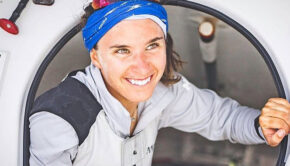
Cole Brauer, Sailor of the Month →
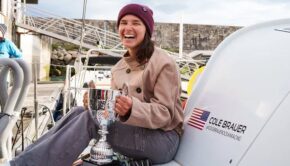
Seahorse Sailor of the Month →
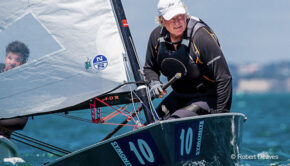
Worry less and sail more →
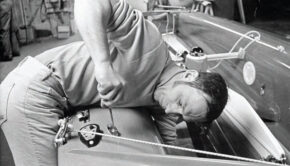
Peter Harken: What an Amazing Guy →
© 2024 Scuttlebutt Sailing News. Inbox Communications, Inc. All Rights Reserved. made by VSSL Agency .
- Privacy Statement
- Advertise With Us
Get Your Sailing News Fix!
Your download by email.
- Your Name...
- Your Email... *
- Comments This field is for validation purposes and should be left unchanged.

- Motorcycles
- Car of the Month
- Destinations
- Men’s Fashion
- Watch Collector
- Art & Collectibles
- Vacation Homes
- Celebrity Homes
- New Construction
- Home Design
- Electronics
- Fine Dining
- Aston Martin
- L’Atelier
- Les Marquables de Martell
- Panther National
- Reynolds Lake Oconee
- 672 Wine Club
- Sports & Leisure
- Health & Wellness
- Best of the Best
- The Ultimate Gift Guide
These Scaled-Down America’s Cup Yachts Are Designed to Let You Live Out Your Racing Dreams
The ac40 is based on the ac75 foiling day-racer designed by emirates team new zealand..
Senior Staff Writer
Bryan Hood's Most Recent Stories
- This Bonkers New Restomod Is a Classic Jaguar With V-12 Power
- Pharrell Williams’s First Car Auction Is Filled With Vintage Classics, From De Tomaso to Lancia
- Bentley’s New Mulliner Will Have Its Most Powerful W-12 Engine Ever
- Share This Article

Now you can experience the thrill of competing in sailing’s oldest and most storied race yourself.
McConaghy Boats has started selling the AC40 , a scaled-down version of the foiling monohull sailing yacht that competes in the America’s Cup . The sleek boat will allow you and a crew of three others to really push yourself to the limits out on the water.
Related Stories
- The Starliner Spacecraft Is Finally Flying Astronauts to the International Space Station
The AC40 is based on the AC75 foiling day-racer designed by Emirates Team New Zealand and built by McConaghy. That vessel competed in the 36th America’s Cup in 2021 in Auckland, New Zealand, and will sail in the next two races. The scaled-down boat is about half the size of the full-size version, with a hull that measures 38.7 feet bow to stern, instead of 68 feet.

McConaghy Boats
The yacht’s monohull is made from carbon composite and features a deck structure with two cockpits for crew members. Like the AC75, the yacht has no keel, and features wing-like hydrofoils mounted beneath its hull. It uses a soft wingsail attached to a two-piece Southern Spars mast to rocket across the water at speeds of up to 44 knots. Rounding out the package are full hydraulic control and electronic PLC and instrumentation systems just like those used by Emirates Team New Zealand.
The boat, which is available for both racing teams and private enthusiasts, arrives ready to sail, with all systems installed and commissioned. You will need a team to take the boat out on the water, though. Two helmsmen and two trimmers are required to sail the yacht, while an autopilot system will keep everything else running smoothly.
Those interested in adding an AC40 to their collection can reach out to McConaghy directly . Be prepared to pay a hefty price, though. The shrunk-down racer will set you back about $2 million, according to Jalopnik . And if you’re worried about whether or not you have the skill needed to make the most of a boat that costs that much, there’s no need to fret. McConaghy also has an in-house simulator to get you up to speed before you hit the water.
Bryan Hood is a digital staff writer at Robb Report. Before joining the magazine, he worked for the New York Post, Artinfo and New York magazine, where he covered everything from celebrity gossip to…
Read More On:
- America’s Cup
- Sailing Yacht
More Marine

Forget a Crow’s Nest. This 207-Foot Explorer Yacht Concept Has Its Own Pop-Up Observatory.

American Magic Just Unveiled Its Sleek New America’s Cup Race Boat

The CEO of Jefferies Just Sold $65 Million in Shares to Buy a Yacht

Forget Pools. This New 131-Foot ‘Mini-Megayacht’ Is Fronted by an Infinity Jacuzzi.

Culinary Masters 2024
MAY 17 - 19 Join us for extraordinary meals from the nation’s brightest culinary minds.
Give the Gift of Luxury
Latest Galleries in Marine

The 12 Best Water Safaris Around the World, From Antarctic Cruises to Botswana River Journeys

EXO-X Explorer Yacht in Photos
More from our brands, bridal designer yumi katsura, who revolutionized the industry, dies, details matter: ncaa settling house and carter won’t end legal woes, emerson collective podcast ‘technically optimistic’ wants to save your digital soul, jeff koons and nonprofit startup clever noodle release children’s literacy game, the best yoga mats for any practice, according to instructors.

The global authority in superyachting
- NEWSLETTERS
- Yachts Home
- The Superyacht Directory
- Yacht Reports
- Brokerage News
- The largest yachts in the world
- The Register
- Yacht Advice
- Yacht Design
- 12m to 24m yachts
- Monaco Yacht Show
- Builder Directory
- Designer Directory
- Interior Design Directory
- Naval Architect Directory
- Yachts for sale home
- Motor yachts
- Sailing yachts
- Explorer yachts
- Classic yachts
- Sale Broker Directory
- Charter Home
- Yachts for Charter
- Charter Destinations
- Charter Broker Directory
- Destinations Home
- Mediterranean
- South Pacific
- Rest of the World
- Boat Life Home
- Owners' Experiences
- Interiors Suppliers
- Owners' Club
- Captains' Club
- BOAT Showcase
- Boat Presents
- Events Home
- World Superyacht Awards
- Superyacht Design Festival
- Design and Innovation Awards
- Young Designer of the Year Award
- Artistry and Craft Awards
- Explorer Yachts Summit
- Ocean Talks
- The Ocean Awards
- BOAT Connect
- Between the bays
- Golf Invitational
- Boat Pro Home
- Pricing Plan
- Superyacht Insight
- Product Features
- Premium Content
- Testimonials
- Global Order Book
- Tenders & Equipment

America’s Cup foiling monohull raceboat design revealed
The Defender Emirates Team New Zealand and the Challenger of Record Luna Rossa have revealed the first details of the design for the AC75 foiling monohull that will race in the 36th America’s Cup .
Challengers heading to Auckland in 2021 will have to master the art of sailing with twin canting T-foils, which can be lifted out of the water on the windward side to reduce drag.
What’s more, the wingsail design has been done away with in favour of a more traditional sailing rig. In a statement, the teams explained: “Whilst recent America's Cup multihulls have benefitted from the power and control of rigid wing sails, there has been no transfer of this technology to the rigs of other sailing classes.”
Safety and stability has been a key consideration and as a result the new AC75 raceboats able to self-right in the event of a capsize, while the foils can be folded under the hull to allow the vessel to fit into a standard marina berth.
It is hoped that this technology will filter through to cruising yachts in future and we have already seen the first evidence of this in the form of the Baltic 142 Custom foiling superyacht.
Grant Dalton, CEO of Emirates Team New Zealand, said: “Our analysis of the performance of the foiling monohulls tells us that once the boat is up and foiling, the boat has the potential to be faster than an AC50 both upwind and downwind.”
Patrizio Bertelli, chairman of Luna Rossa Challenge, added: “The choice of a monohull was a fundamental condition for us to be involved again in the America’s Cup. This is not a return to the past, but rather a step towards the future.”
British contender Sir Ben Ainslie , team principal and skipper of Land Rover BAR, gave his backing to the design, claiming that it will add to the growing popularity of the America's Cup .
"The sport has gained a lot of new fans and this boat, delivered with a global circuit and high-quality free-to-air broadcast TV will cement their interest in the America's Cup and build on a very strong base," he predicted.
This dramatic design has spent four months in development and will be refined further before the AC75 Class Rule deadline of March 31, 2018.
More stories
Most popular, from our partners, sponsored listings.
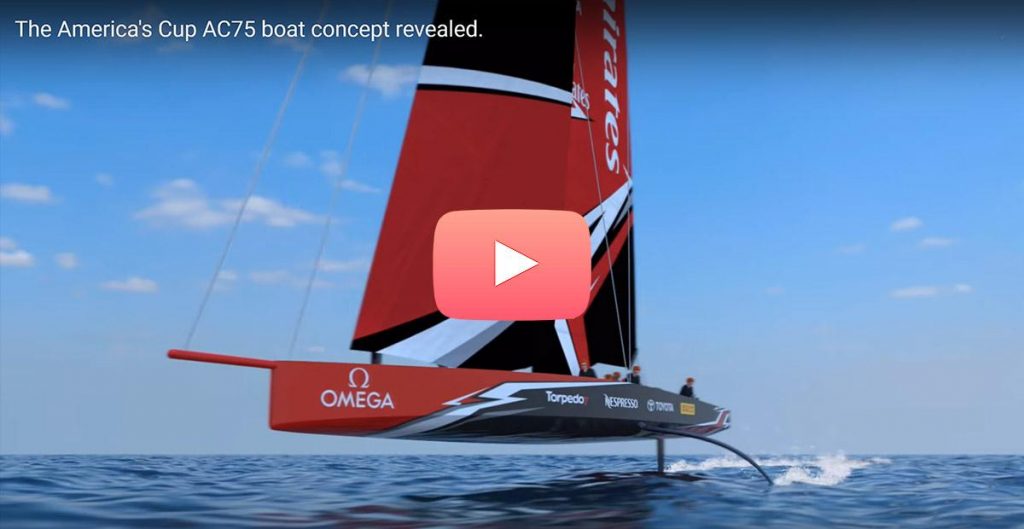
Here is the America’s Cup Class AC75 boat concept

The concept of the AC75 , the class of high-performance monohull racing yachts to be sailed in the 36th America’s Cup , has finally been revealed.
Compared with the previous editions managed by Alinghi and Oracle teams, this new concept marks an exciting new era in America’s Cup racing. However, what doesn’t change is the fully foiling catamarans’ ability to fly on the water , a feature that was already present on board the AC50 yachts.
As already announced during the presentation of the Protocol for the next America’s Cup, the concept of the new fully foiling monohull yachts equipped with canting foils has been unveiled before the end of November.
The choice of a monohull has been already announced by the two main players on the ground. Patrizio Bertelli, patron of Prada , launched the first challenge for the next America’s Cup with the Circolo della vela Sicilia , and as such became Challenger of Record and earned the power to decide the rules together with the Royal New Zealand Yacht Squadron . The abandonment of multihulls and the subsequent return to monohulls was necessary to enable the fashion entrepreneur to join a new challenge. The choice was strongly supported by Grant Dalton, Chief Executive Officer of Emirates Team New Zealand , maybe even more convinced of this change of course.
Monohull and high-performance, the new racing yachts demand highly competent sailors. Sailing cyclists disappear and grinders come back with more “normal” foresails. “Anyway, they will be faster than the AC50 catamarans both upwind and downwind “, claimed the authoritative Kiwi sailing’s representative.
Foils seems to be the most striking novelty. The concept is totally different from what we are used to see on the Imoca 60 yachts , the only class of racing boats that is actually able to fly over the water. Unlike ocean monohulls where twin foils have a single shaped blade, the AC75 yachts feature two canting foils of over 5 meters equipped with a curved shaft and a long terminal T-section.
The central bulb disappears and even the helm takes on a T layout. This way, the hull will be raised out of the water , like the Moth or old AC50 yachts, in order to reduce the sudden “jumps” of the Imoca 60 yachts.
The foils are set in various positions depending on the angle of attack and manoeuvring requirements. In normal sailing mode, the leeward foil will be in the water to provide lift and the windward foil provides righting assistance. Both foils can be employed for maximum stability in manoeuvres and difficult conditions. Furthermore, foils are planned to be self-righting in the event of a capsize.
Further details will be unveiled at the end of March 2018, when the complete class rules will be released. What seems to be certain is a definitive goodbye to rigid wings while the mainsail might be inflatable. The new hull design will be open and the yachts may have soft sails, including a Code 0 for light winds crossovers.
This way, both the yachts and the Cup are expected to enter a new revolutionary era. ” This Cup is an important step towards the future: the concept of the new AC75 Class will open new horizons for racing yachts which, in the next future, may also extend to cruising “, Bertelli stated.
Leave a Reply Cancel reply
Your email address will not be published.
Save my name, email, and website in this browser for the next time I comment.
You might be interested in
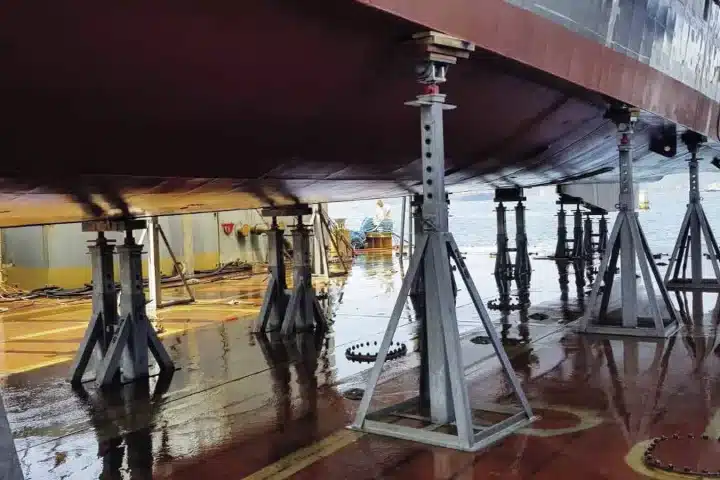
Choosing the perfect cradle: boat stands, cradles, heels and trailers
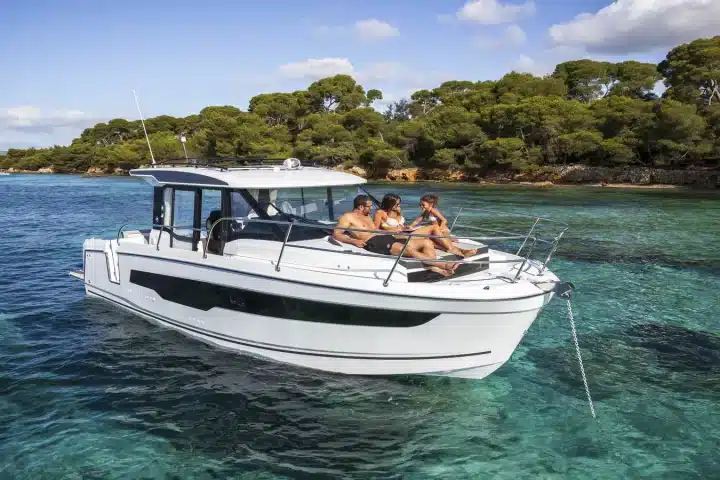
MERRY FISHER 895 Series 2, the year-round weekender
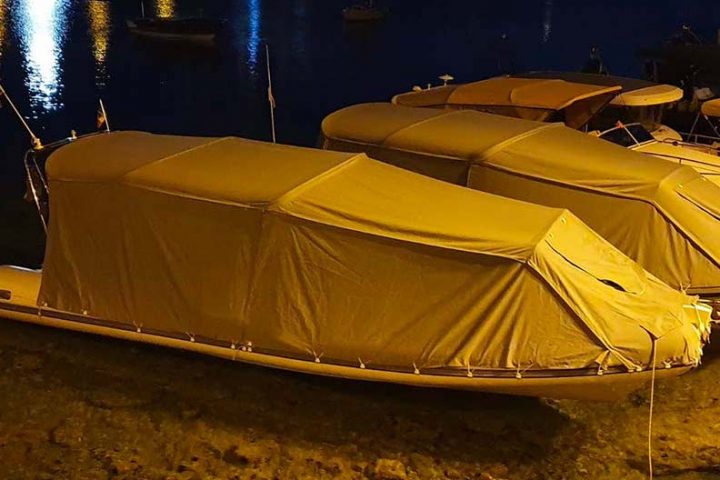
Boat Camping Guide: the tent to sleep on board
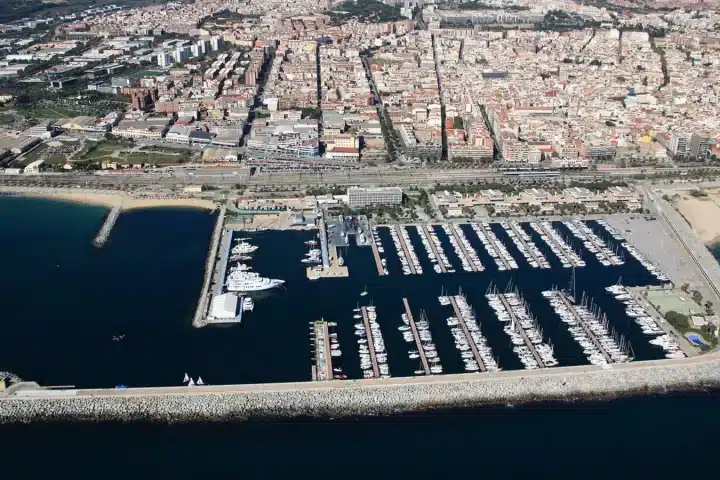
The Catalonia International Boat Show is born: first edition scheduled from May 17-19
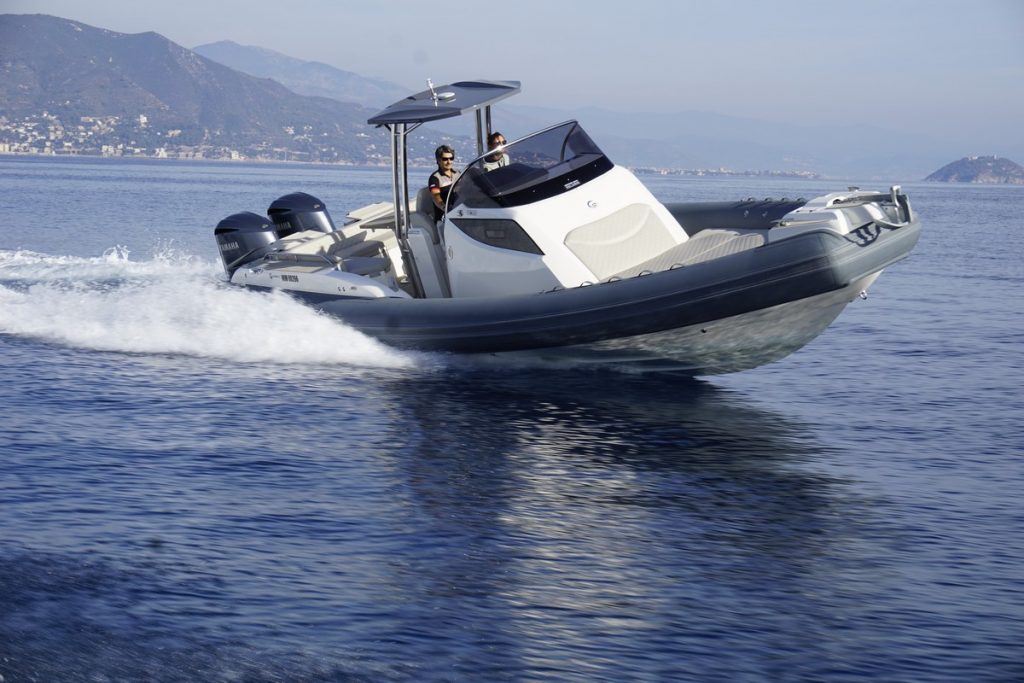
On Test. Capelli Tempest 38 and Yamaha 350hp outboard
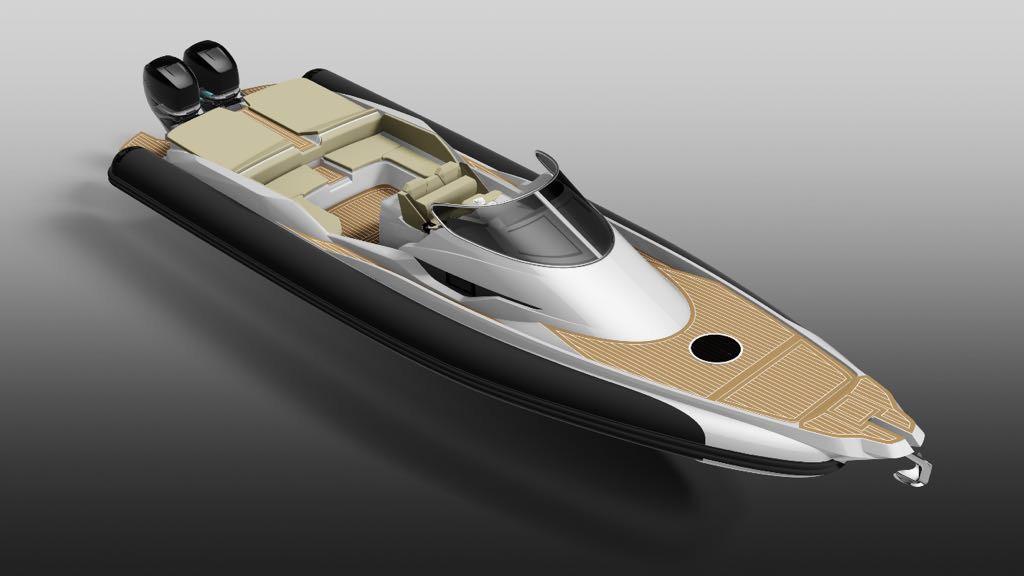
Nuova Jolly presents two world premières in Paris: the Prince 38 Sport Cabin and the NJ 700

To provide the best experiences, we and our partners use technologies like cookies to store and/or access device information. Consenting to these technologies will allow us and our partners to process personal data such as browsing behavior or unique IDs on this site and show (non-) personalized ads. Not consenting or withdrawing consent, may adversely affect certain features and functions.
Click below to consent to the above or make granular choices. Your choices will be applied to this site only. You can change your settings at any time, including withdrawing your consent, by using the toggles on the Cookie Policy, or by clicking on the manage consent button at the bottom of the screen.
Subscribe For Latest Updates
Sign up to receive the best of Yachting News, sea trials, boat review and world premieres .
The only ADVERTISING FREE newsletter
This website uses cookies . This allows us to offer you the necessary functionalities and also improve your user experience. If you visit our website, you agree to the cookie statement
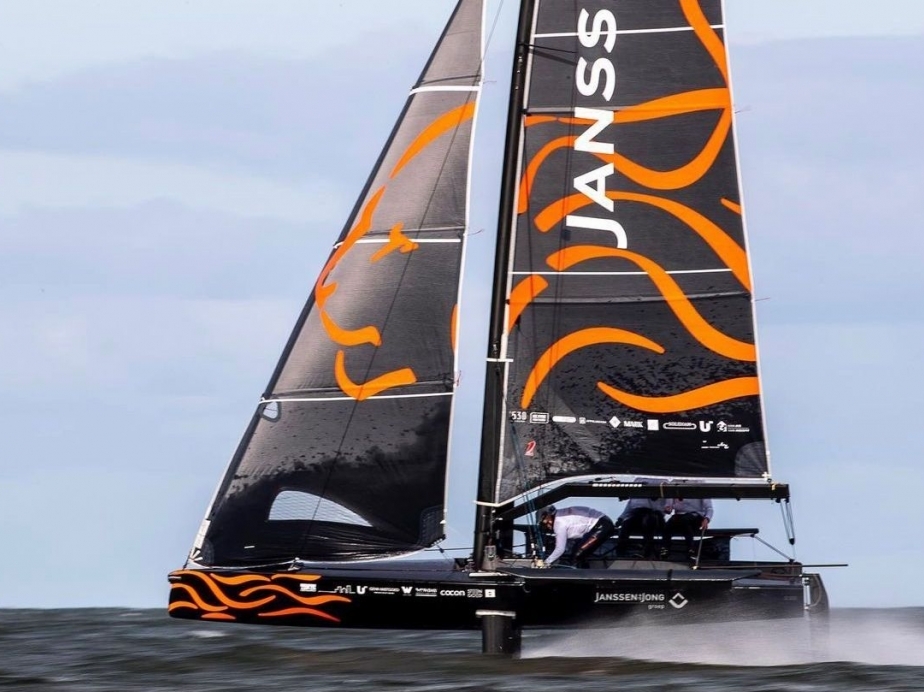
69F Persico foiling monohull
€119,000
VAT excluded
- Reference ID 670
- Builder 69F
- Wilson-Marquinez Naval Architecture
- L.O.A. (mtr) 6.90
- Draft (mtr) 1.70
- Displacement (Kg) 380
- Material Carbon
Send to friend
Yacht description.
Comments owner:
Our 69F is in great shape. On trolly and easy loading road trailer. With lot’s extra’s, all lines spare new, Sailmon 2x, windmeter, all tools needed and more. Selling because of ending program and focussing more on offshore sailing.
Available 1st Oktober 2022.
About the 69F
Persico 69F is a mono-hull foiling sailboat designed by the Argentinian firm Wilson-Marquinez to offer to the widest possible sailing public a small foiler, using a concept borrowed from the AC75, the new boat for the 36th America’s Cup. The prototype has already sailed for numerous days on Lake Garda, where it has been tested by top-ranked sailors, among whom the Olympics multiple medal-winner Santiago Lange, a living legend in the sport of sailing. Santi Lange has also taken on the initiative of starting an academy to popularize sailing on foils and train teams to participate in the new Persico 69F regattas circuit. Persico Marine’s competence in the yacht racing field is renowned at the world level. For the innovative 69F, the firm has availed itself of its specific know-how acquired from the series production of VO65s, the larger advanced high-performance One Design boats currently sailing. Moreover, on the subject of state-of-the-art one-design crafts, Persico Marine is the Official Supplier of the famous foil arms for the next America’s Cup, to be held in Auckland in 2021. These parts, which are used to keep the AC75s up on their foils, have been supplied to all teams and are absolutely identical in all respects.
The Persico 69F has been created as a strict one-design boat where the true test when racing is between crews and not boats and equipment. The fundamental objective of these rules is to ensure that this concept is maintained.
As indicated by its name, the Persico 69F is 6.90 metres in length. The canoe body is made of extremely light carbon fibre and shows a form stability that allows the new craft to fill the current gap between the highest performing displacement boats and a true foiling boat. Designed for a crew of 3, the 69F is fitted with a couple of racks with seats to facilitate handling and for a safer sailing, a V-shaped foil, a T-shaped rudder, a daggerboard system and 40 square metres of sail area (45 sqm code 0) which already at 7 knots can lift the boat’s weight of only 380 kg. If there is a mixed-gender crew, it would be possible to sail with 4 people.
Persico 69F hulls, appendages, rigs and sails are manufacturing controlled.
- Beam: 2.1-4.6
- Sailarea 40m2
- New and better mast and boom coating
- new rack and net.
New sails from 2021
- One training and one race kite.
Electronics and Navigational Gear
- trolly
- easy loading road trailer
- all tools needed
- covers
The Company offers the details of this vessel in good faith but cannot guarantee or warrant the accuracy of this information nor warrant the condition of the vessel. A buyer should instruct his agents, or his surveyors, to investigate such details as the buyer desires validated. This vessel is offered subject to prior sale, price change, or withdrawal without notice.
Featured yachts for sale.
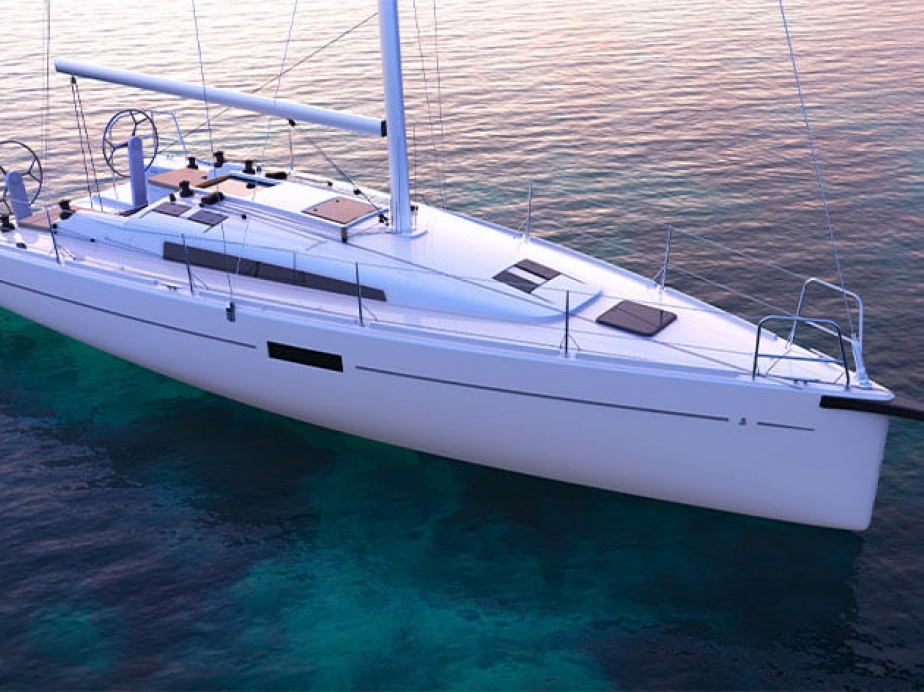
- Displacement (Kg): 4800
- Beam (mtr): 3.80
- L.O.A. (mtr): 11.98 Meters
- Horsepower: 29 hp
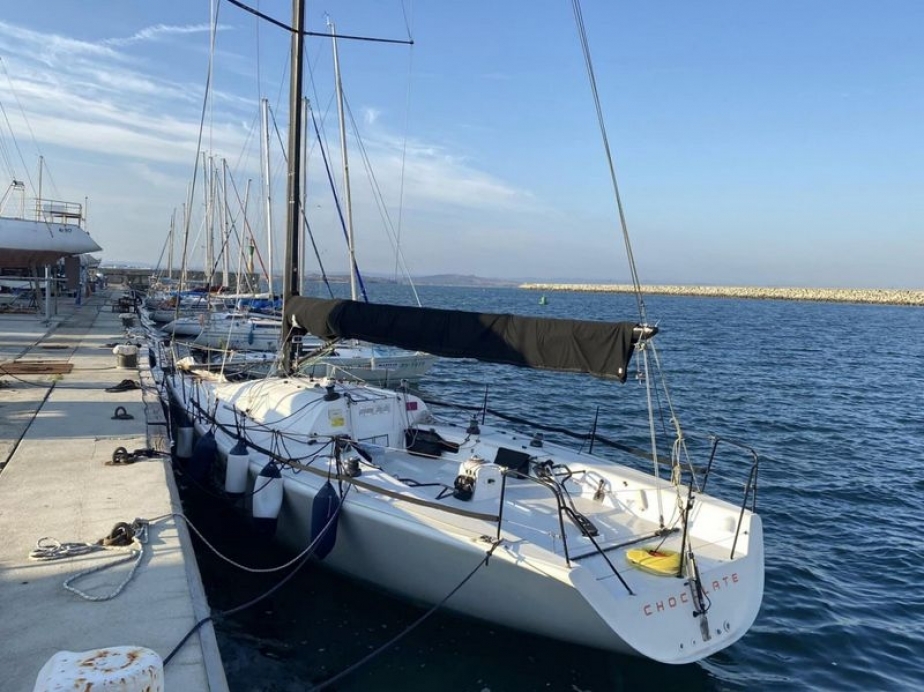
- Displacement (Kg): 5008
- Beam (mtr): 3.95
- L.O.A. (mtr): 12.41 Meters
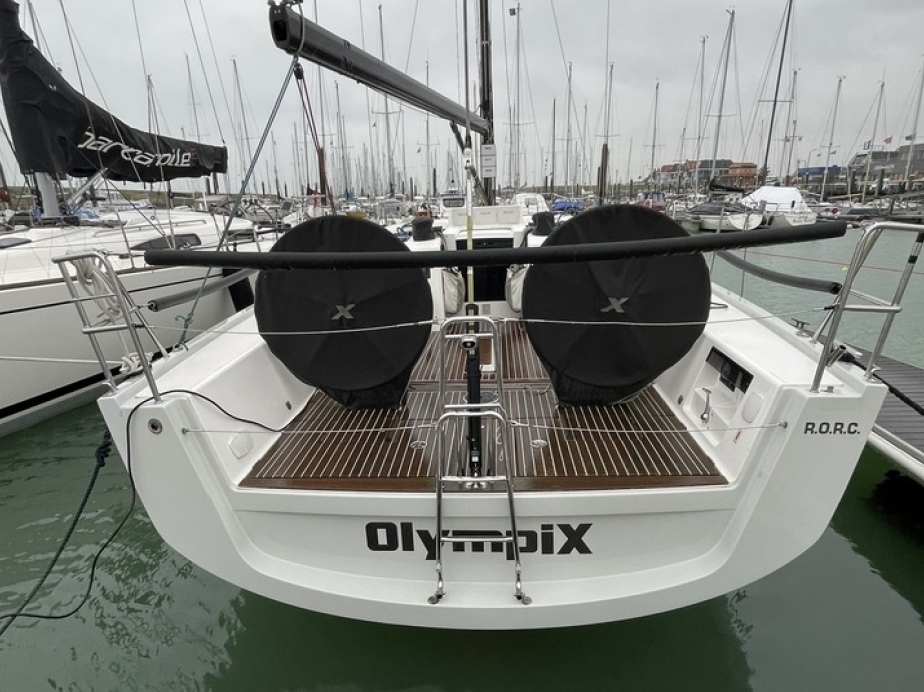
- L.O.A. (mtr): 12.50 Meters
- Horsepower: 40 hp
The Lyncean Group of San Diego
The amazing america’s cup ac75 foiling monohull flying boat.
Peter Lobner, 25 February 2021
The first race of the 36 th America’s Cup racing series starts on 5 March 2021 in Auckland, New Zealand. The defending Emirates Team New Zealand and the challenging Luna Rossa Prada Pirelli Team will be sailing (or rather flying) a radical new class of America’s Cup boats knows as the AC75, which is a foiling monohull that was designed from the ground up to “fly” on its foils. It isn’t clear if the AC75 is a flying boat or a sailing airplane.
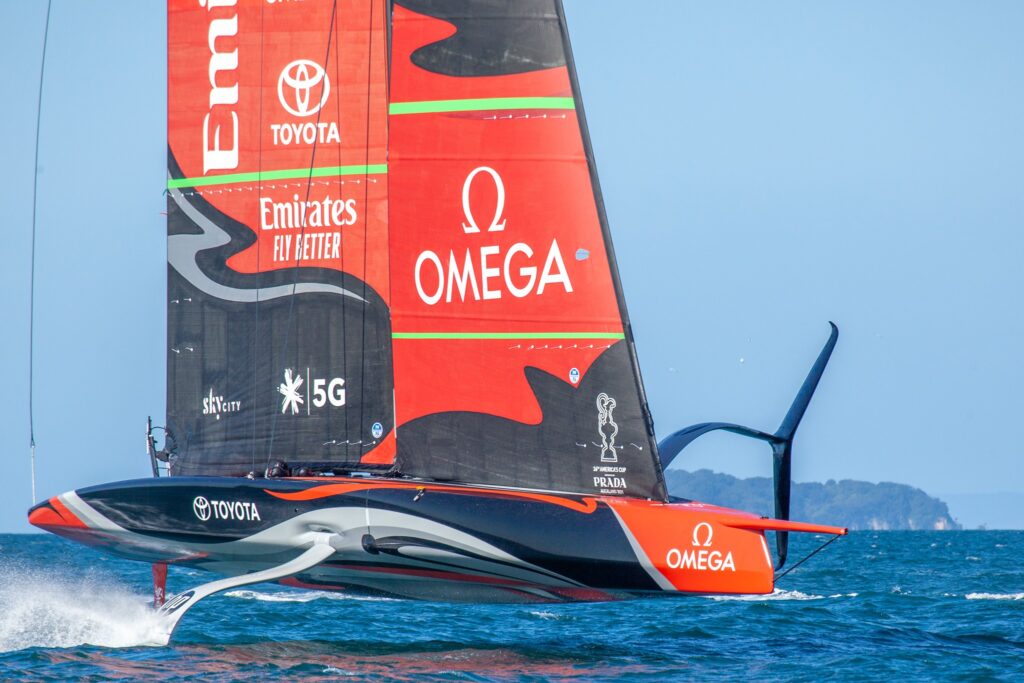
The Luna Rossa Prada Pirelli Team won the right to challenge based on its performance in the Prada Cup match races held from 14 January thru 20 February 2021. The America’s Cup races are scheduled from 5 to 14 March 2021. You’ll find complete information on the races on the America’s Cup website at the following link: https://www.americascup.com
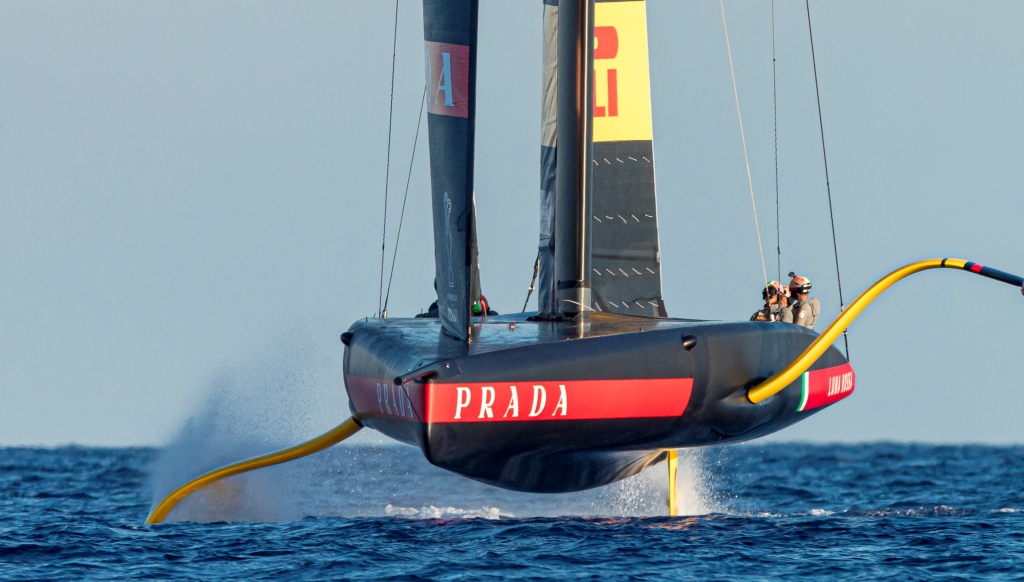
The New York Yacht Club American Magic entry, Patriot , was eliminated during the Prada Cup races, after recording no wins in the Round Robin series and no wins in the semi-final races against Luna Rossa . Patriot was damaged and in danger of sinking following a dramatic high-speed capsize following a tack in gusty wind conditions while leading Luna Rossa during Round Robin 2 Race 3 on 16 January 2021.
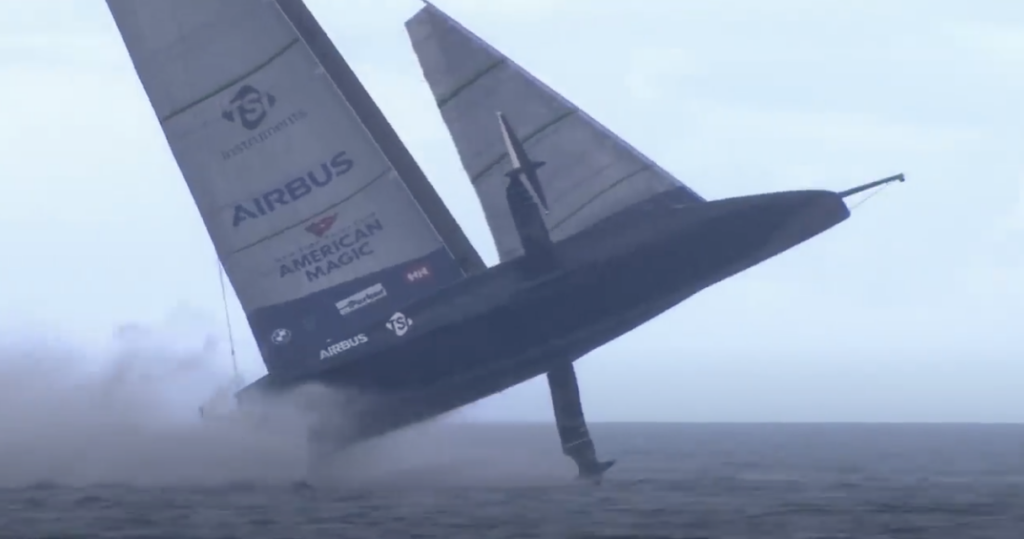
The AC75 operates with two completely different sets of boat dynamics:
- Waterborne while accelerating at maximum power to quickly reach foiling speed at 12 – 14 knots
- Flying on the foils to reach a top speed that can exceed 50 knots
Making a smooth transition from waterborne to flying on the foils can be a big challenge for the crew. As the transition is being made, the power demand drops rapidly (suddenly) as the hull emerges from the water and starts flying on the foils. The crew must quickly adjust sail power and trim to maintain control of the flying boat.
As you would expect, there are extensive regulations governing most aspects of the boat’s design. The Rule is explained at the following link: https://www.americascup.com/en/official/the-class-rule
To get an introduction to an AC75 boat and its primary components, you can view a 3-D model here: https://www.americascup.com/en/ac75
The AC75 is a very lightweight vessel, with a fully-loaded weight of 7,600 kg (16,800 lb). The empty weight, not including sails or crew, is limited to 6,520 kg (14,374 lbs.). Of that, 3,358.5 kg (7,403 lb) is supplied by, or specified by, the America’s Cup event organizer, and includes the following standard items for all teams.
- Mast : A detailed specification; essentially a one-design mast with a D-shaped leading edge; teams can choose their manufacturer.
- Rigging : Supplied to all teams.
- Media equipment: Cameras, mounting hardware, power & controls supplied to all teams.
- Foil cant arms and hydraulic control system : Standard system developed, tested and supplied to all teams by one manufacturer. The hydraulic system is powered manually by hand-operated grinders. The hydraulic system includes an interface to the trailing edge flaps on the foils supplied by each team.
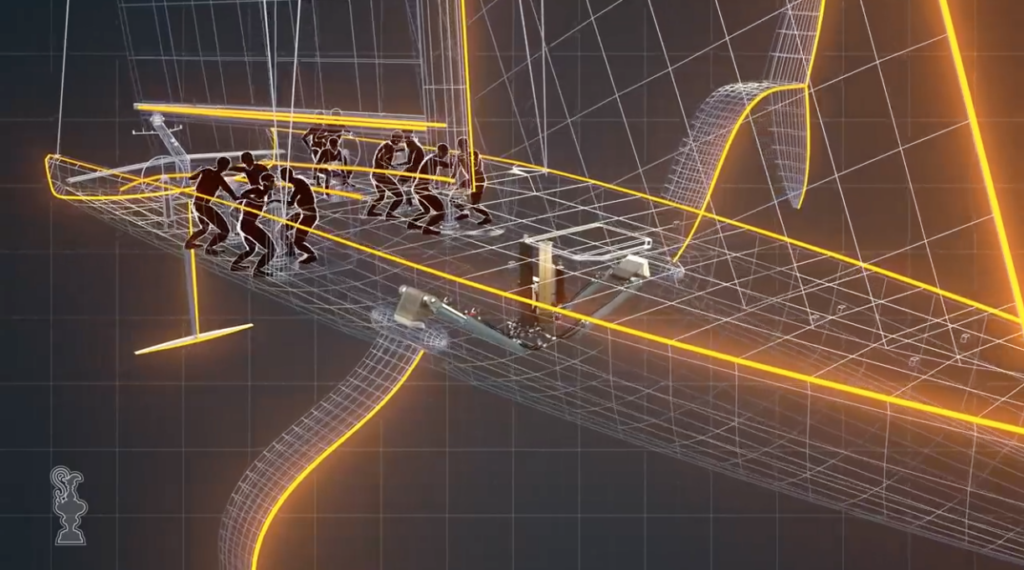
Each team is responsible for designing and building the rest of the boat while remaining within an empty weight budget of 3,161.5 kg (6,968 lb). The primary areas for innovation by each team are the following:
- Hull design: (maximum length 75 feet / 22.86 m), with the primary choice being a flat bottom or with skeg to provide a less sensitive transition between waterborne and foil borne modes.
- Crew and hand-operated grinder placement
- Twin-skin soft main sail: Forms a fabric 3-D airfoil
- Single-skin soft head sails
- Rudder + stern foil
- Foil wings, fairing and active trailing edge flaps: These are mounted to the standard cant arms; foils must be symmetrical with a maximum span 4 meters; flaps control lift; total weight is limited to about 1/3 rd the weight of the empty boat.
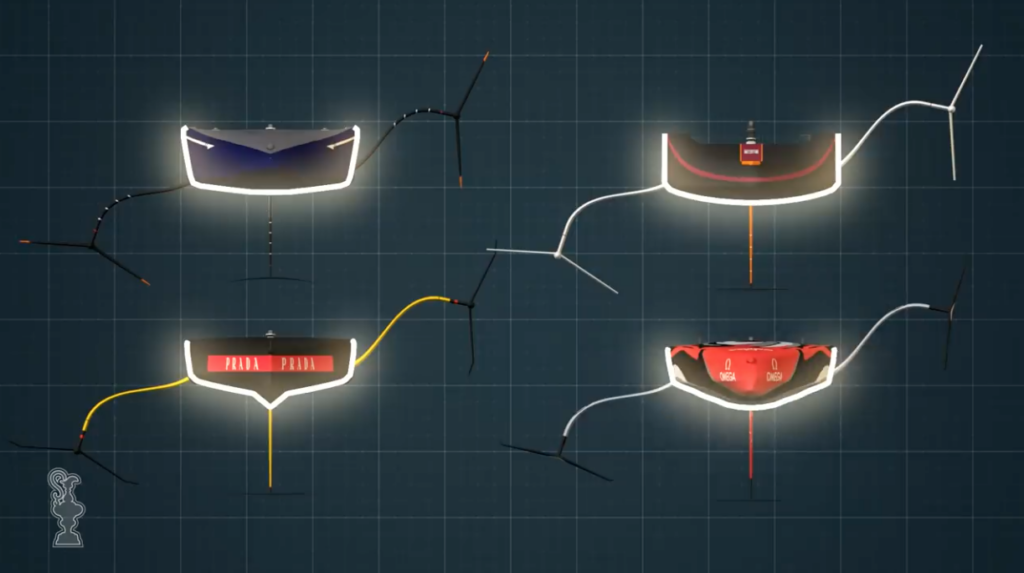
There are many AC75 videos available online, including many covering the exciting Prada America’s Cup World Series races in December 2020 and the Prada Cup races in January – February 2021. These boats are so fast that the races are short and action packed. I’ve listed several videos focusing more in boat technology below.
I hope you’ll enjoy a few of the AC75 videos and follow the America’s Cup Races. It’s not like any yacht racing you’ve seen before.
For more information:
- “The AC75 – The Technology,” Americas Cup: https://www.americascup.com/the-technology
- Mark Chisnell, “Weighing in on the AC75,” Sailing World, 15 September 2020: https://www.sailingworld.com/story/racing/weighing-in-on-the-ac75/
- Christopher McFadden, “The Engineering and Design Behind Modern Racing Yachts,” Interesting Engineering, 23 February 2021: https://interestingengineering.com/the-engineering-and-design-behind-modern-racing-yachts
- “The AC75 | Designed to Fly” (7:25 minutes), America’s Cup, 2 August 2020: https://www.youtube.com/watch?v=VQUl_hf6yo8&feature=emb_logo
- “America’s Cup – How Crews Handle Their AC75s” (17:41 minutes), Americas Cup, 24 January 2021: https://www.youtube.com/watch?v=o0bReWK_vsg
- “Sea Wolves – The new America’s cup boat! AC75 Technology analysis/Deep dive special! Auckland 2021” (51:07 minutes), Sea wolves, (with an introductory review of Americas Cup history by Troy Sears, owner of the replica yacht America , which is home ported in San Diego, CA), 16 December 2020: https://www.youtube.com/watch?v=sjs76uHEqeM
- “The American Magic Capsize – A Step by Step Explanation” (8:32 minutes), America’s Cup, 24 January 2021: https://www.youtube.com/watch?v=pXLUIouASdM
More From Forbes
Maserati introduces all-electric tridente watercraft at folgore day.
- Share to Facebook
- Share to Twitter
- Share to Linkedin
Overhead view of the all-electric 10.5-meter Maserati Folgore Tridente luxury watercraft. Not the ... [+] first Maserati to take to the sea, sailing yachts monohull Maserati Mono 470 in 2012 and trimaran Maserati Multi 70 in 2016 preceded the Tridente.
Translating to “thunderbolt” from Italian, Folgore is the umbrella marque for Maserati’s all-electric powertrain vehicles. That includes possibly the most interesting member of that elite club, the Tridente all-electric luxury watercraft.
Quite the show featuring Dardust, Edwige Pezzulli, and Matilda De Angelis, the spark and passion of this iconic Italian brand was totally plugged in as Maserati announced the "Made in Thunder" Folgore models. The event underscored Italian status as party starters and mood switchers, claiming that “Anywhere we go, Boom! Things turn on.”
Two models under the Maserati Folgore "Forged in Thunder" brand, the GranCabrio Folgore open top ... [+] automobile and the Folgore Tridente luxury watercraft, launched at Folgore Day.
Held on Maserati’s 110 th anniversary, the event also launched the GranTurismo Folgore all-electric car, the Grecale Folgore full-electric powertrain SUV, and the GranCabrio all-electric Folgore open-top version of her grand touring sister. A 2025 debut is planned for the MC20 Folgore super sports car. By 2028, with the anticipated launch of the Quattroport Folgore, Maserati’s lineup of “adrenelectric” Folgore vehicles will be fully electrified.
Exclusive Employers Are Souring On Ivy League Grads While These 20 New Ivies Ascend
New ios 18 ai security move changes the game for all iphone users, nyt strands hints spangram and answers for monday april 29th, about the boat.
Measuring 10.5 meters, Tridente is capable of a top speed of 40 knots with a cruising speed of 25 knots delivering a range of 70 km. Peak power of 600 HP and battery capacity of 252 kWh gets a full recharge in under an hour. This chic superyacht sidekick would be right at home as a yacht tender whether in Monaco or Montauk, or cruising solo around any beautiful lake, whether Como, Tahoe, or Lucerne.
Profile of the Maserati Folgore Trident all-electric 10.5-meter watercraft.
The cockpit can be configured either for cruising or dining, comfortably seating eight passengers. In addition to the wraparound banquette, an aft facing settee at the swim platform allows an additional at anchor perch. A ladder and handheld shower are nice swim platform amenities. The cabin below houses a berth and a head.
Maserati partnered with Vita Power to deliver a no-compromise electric and integrated system of high-performance electric propulsion. Vita is a marine technology company founded to reduce the impact on the marine environment through ecosystems designed specifically for recreational and commercial vessels. The Vita Power system is supported by a dedicated marine fast charging infrastructure.
Closeup of the Maserati Folgore Tridente cockpit, which seats eight and can be configured either for ... [+] accelerating or dining.
Maserati Head of Design Klaus Busse stated, “ Maserati and Vita Power share the same vision on electrification and both build the vehicles of the future, based on reduced environmental impact, improved customer experience, advanced technology, high quality and sophisticated materials. Our creations are both finished to the highest standards of craftsmanship, enhanced by beautiful and functional design, without sacrificing performance and elegance. Maserati Folgore is the standard bearer of our full electric production, and we are proud to extend our new course to the sea, collaborating with a company synonymous with passion, excellence and luxury in the new electric era."
Sculpted of carbon fiber, the vessel is finished by US boatbuilder Hodgdon Yachts . Notable nautical artisans located in Damariscotta, Maine, Hodgdon owns 200 years of historic precision boatbuilding, crafting custom tenders for many of the world’s elegant superyachts.
Maserati, the only luxury brand in the clutch of parent company Stellantis marques, has just ... [+] introduced the Tridente at Folgore Day in Rimini, Italy, marking the 110th anniversary of Maserati brand.
Hodgdon Yachts Managing Director Audrey Hodgdon acknowledged, “This is the first fully electric boat that we have built and we are pleased about our involvement in the project. Our company began over 200 years ago and it’s exciting that electrification is now a part of our story moving into the future.”
Made In Thunder, and Made In Italy
Under the Stellantis marque, Maserati remains 100 percent designed, developed, and manufactured in Italy. Brand CEO of Maserati David Grasso commented in the Folgore Day celebration, “Today we write the future. We own our destiny. We lead the change," concluding with, "We are Maserati. We turn the future on.”
Electric vehicles, known for their quiet startup and acceleration, might call for a rewrite of the familiar " Maserati music. " Some prefer the silence, but others may look for a little something there. Whether the Folgore lineup, boats and cars alike, will maintain an audio Maserati signature sound is still in question. Answers are available for $2,660,000, with the first hull already on the market and available.

- Editorial Standards
- Reprints & Permissions
Yachting World
- Digital Edition

Radical 75ft flying monohull ‘could be fastest America’s Cup design ever’
- Elaine Bunting
- November 21, 2017
Emirates Team New Zealand has unveiled the new AC75 monohull for the next America's Cup and this incredible new flying monohull could be faster than the AC50 catamarans

One of the fastest and most futuristic sailing designs in history has been unveiled by Emirates Team New Zealand (ETNZ) and challenger of record Luna Rossa as the class for the next America’s Cup in 2021.
The new AC75 will be a fully flying monohull. Instead of a keel, it has two canting, ballasted T-foils to provide righting moment and the ability to self-right the boat in the event of a capsize. Like the catamarans of the last Cup, it will be able tack and gybe on foils.
Early computer modelling suggests it could be even faster than the AC50 catamarans and look even more spectacular.

It marries some of the best features of the multihulls, such as high speed and design innovation, to traditional monohull sailing action and manoeuvres. The new design will be raced by 12 sailors and the animation suggests a return to traditional grinders (no more ‘cyclors’?). The new design may have a wingmast and soft sails including a Code 0 for light winds crossovers.
As the video released by ETNZ shows, this is unlike any boat previously seen. Watch this video to see how it will work.
The new design is the result of four months working through different concepts, led by ETNZ’s design co-ordinator, Dan Bernasconi. The eventual design was always going to be a monohull because that is what ETNZ had agreed Luna Rossa in exchange for funding and design tools that assisted their victory in Bermuda.
“We are really proud to present the concept of the AC75…Our analysis of the performance of the foiling monohulls tells us that once the boat is up and foiling, the boat has the potential to be faster than an AC50 both upwind and downwind. Auckland is in for a highly competitive summer of racing in 2020/2021,” said ETNZ’s CEO, Grant Dalton.
The only other fully funded and confirmed team for 2021, Ben Ainslie’s Land Rover BAR, was not consulted about the design choice, but were given a heads-up in recent weeks. The team’s new CEO, Grant Simmer, who most recently worked with Oracle Team USA, says: “I think we were surprised that they went for such a bold solution, but we applaud it. It’s a strong technical challenge but a good call and in the spirit of the Cup.”
But he says that campaigns will not be less expensive. “We anticipate that they will actually be more expensive,” comments Simmer. With most of the money being spent on development and salaries, and the sailing teams increasing to supply a race crew of 12 people, Cup teams might spent even more than the €100 million-plus that they each laid out for Bermuda.
But one-design elements of the class have been promised, which might make it easier for new and first-time teams to form for the next America’s Cup and still be competitive. ETNZ is to announce the full class rule details next March but has already indicated that the hydraulics, batteries and control hardware for the foils, for example, could be one-design, with scope for development of control system software.

ETNZ has also said specifically that fully autonomous autopilot systems for controlling the position of the foils will not be allowed. Key controls such as the flaps of the T foils and their cant position will have to be adjusted manually by crews.
The foils will enter the hull topsides and go through a wet box area, where they will be operated by hydraulic rams that move then in and out and from vertical to horizontal position. On a traditional monohull the keel attachment is the area of highest load, but here it will be these foil attachments.
Choosing a rotating wingmast and soft sails rather than a wingsail that needs to be craned on board each time the yacht races is pointed to as having more ‘trickledown’ potential for other areas of sailing. But the decision has also been taken because once these boats are foiling, the restrictions on speed come from either foil cavitation or aero drag, and designers believe that it will be easier to manipulate a soft wingsail to reduce drag.
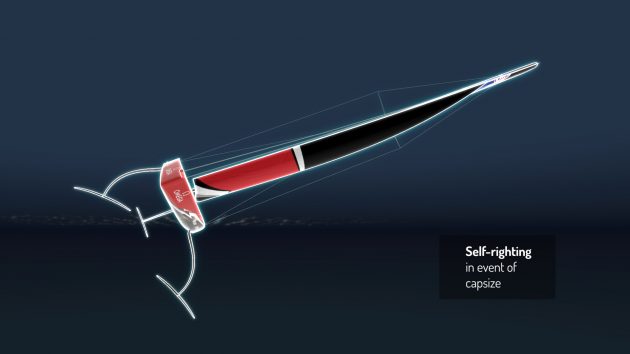
Although not offshore yachts, they will also be able to race in a wider variety of sea conditions, including the choppy wind over tide conditions seen in the Takapuna area of the Hauraki Gulf. Experts believe that it might be possible to control ride height sufficiently to race, fully foiling, in waves of around 1m.
If designing and building such futuristic boats is a huge set of challenges, so will racing these beasts. “We are in the early days of modelling, but there will be big changes in righting moment so manoeuvring will be incredibly challenging,” observes Grant Simmer. The new design promises to open up another immense new chapter in foil development and sailing technique.

FoodFindsAsia.com
Your One-Stop Resource for Restaupreneurs and Foodies in the Philippines and Southeast Asia
8 Yacht Clubs and Marinas in the Philippines to Moor Your Boat In

FoodfindsAsia.com | 8 Yacht Clubs and Marinas in the Philippines to Moor Your Boat In | Filipinos’ history as a maritime people date back to prehistoric times. In fact, the Philippines’ basic sociopolitical unit today, the barangay, traces its etymological origins to the balangay , the ancient outrigger boats that were used by precolonial Filipino communities to explore and conquer islands this side of the Pacific. As a people belonging to a seafaring culture, it’s no wonder that modern Filipinos are taking a retrospective look at their glorious past as Austronesian mariners and are developing a renewed love for the ocean and marinas as present-day yachtsmen.
Today, Philippine marinas look to accommodate more and more yachts and other pleasure watercrafts as the years go by. In 2017, an ASEAN Briefing op-ed piece named the Philippines as a country with high potential in yacht industry growth. The natural beauty of the Philippine islands and its fantastic bays, combined with a growing interest in leisurely sea travel, can explain the spike in yachting activities throughout the country.
Are you part of the demographic that’s become enamored of the yachting lifestyle? Do you want to know where in the country you can berth your watercraft? Leading sailboat and motorboat authority Europa Yachts is happy to enter the conversation, and recommends the following locations for discovering the Philippines through yachting. Here is a short list of clubs and marinas in the country, organized by island region.
Manila Yacht Club and Marina, Manila, Metro Manila
Established in 1927, the Manila Yacht Club and Marina is one of the oldest yacht clubs in all of Asia, and is nestled in the scenic Manila Bay. It is also near other well-known landmarks in the city, such as the Cultural Center of the Philippines (CCP), the headquarters of the Philippine Navy, and the US Embassy. Facilities in the marina include a launching ramp and a fueling center, and the club itself is host to a restaurant and gorgeous function rooms. The Manila Yacht Club only welcomes visitors who arrive by boat, and it charges an initial security deposit of USD 750 upon arrival. Club membership is mandatory for medium and long-term mooring of boats.
Subic Bay Yacht Club, Zambales
The Subic Bay Yacht Club, which was founded in 1998, upholds itself as the country’s premier yacht club. It operates in the deepest bay in the country, and can host vessels well beyond 50 meters in length. Already benefitting from the innate beauty of the Zambales mountains surrounding it, the club hosts a number of other attractions, including its luxury accommodations, swimming pools, and its own movie theater, bowling alley, and nightclub. Those who venture outside of the club’s premises can also shop for well-priced imported goods at the Subic Freeport Zone, engage in water sports , or sign up for diving excursions.
Punta Fuego Yacht Club, Batangas
Peaceful Punta Fuego is a mecca for those who love the sport of sailing. As per its official website, the Punta Fuego Yacht Club aims to serve “a dynamic and vibrant community of boat enthusiasts and yacht owners.” This it does by playing host to a diverse population of watercrafts, from large catamarans and mono-hull yachts to small boats. Non-members of the club may use the berths for up to 3 weeks, and can refuel at the marina’s fueling station. The yacht club offers other amenities such as locker rooms, shower rooms, Internet facilities, a chart room, and a restaurant called Barracuda Bar, which serves delicious fares. Outside of the yachting crowd, Punta Fuego Yacht Club also caters to those wishing to celebrate weddings, conferences, and corporate events in their opulent quarters.
Puerto Galera Yacht Club, Oriental Mindoro
Further south, yachtsmen may moor at the Puerto Galera Yacht Club in Oriental Mindoro, an island location that’s home to tourist attractions like the Sabang Wreck dive site, lively beachfront resorts, and the Malasimbo Music Festival. Puerto Galera Yacht Club has been in operation for almost thirty years and lends services such as refueling provisions and yacht repairs from its marina. Boat owners also enjoy optimal convenience if mooring here, as they can also shop for spare parts in the nearby Batangas port.
Busuanga Yacht Club, Puerta del Sol Bay Marina, Palawan
Beautiful Palawan is a bucket-list destination for many, especially those who dream of cruising its crystalline waters. Accommodating the yachting community in this island province is the Busuanga Yacht Club, which promises secure mooring amidst breathtaking white-sand beaches. Here, each vessel will benefit from a typhoon-safe harbor, easy refueling, and direct access to transportation hubs like the New Busuanga Airport. Adjoining this marina is the Puerta del Sol Bay Resort, which offers luxurious accommodations to visitors. When not atop the deck of a boat, travelers can also explore the lagoons and freshwater lakes of Coron, go shipwreck diving, or relax in the hot springs of Maquinit.
Iloilo Sailing Club, Arevelo, Iloilo City, Iloilo
Iloilo Province is home to some of the country’s most beautiful old-world architecture, a flourishing ecotourism industry, and delectably fresh seafood cuisine. What will round off an unforgettable visit to Iloilo, however, is an excursion to the Iloilo Sailing Club on a leisure watercraft. The club accepts visitors and encourages membership in the case of medium and long-stay mooring. It also hosts a number of amenities and activities, including a dinghy storage, a beach bar and restaurant, and classes for those who want to learn about sailing. In recent months, the Iloilo Sailing Club has also been a convenient meet-up point for big maritime events, such as the Iloilo-Guimaras Paraw Regatta and the Seafarers’ Job Fair.
Cebu Yacht Club, Mactan Island, Cebu
The historic Mactan Island in Cebu was the site of Portuguese explorer Ferdinand Magellan’s arrival in the Philippines. Now known as a commercial hub that hosts a prolific furniture and musical instruments industries, Mactan is also the location of the Cebu Yacht Club, an institution that is beloved by the locals. Aside from being an ideal spot to restock on much-needed fuel and supplies, the Cebu Yacht Club is also a trusted club to commission for boat repairs. There’s a good vibe in this club for everybody, as it sports both luxury accommodations and a waterfront strip of restaurants that laid-back diners can frequent. MINDANAO
Holiday Oceanview Marina, Samal Island, Davao del Norte
The Holiday Oceanview Marina is a major attraction of Samal Island in Davao del Norte Province, one that welcomes Filipino and foreign yachtsmen alike to moor within its premises. The space is quite roomy, in fact, with 56 berths that can fit vessels up to 15 meters in length. The club also has a boat ramp that can accommodate boats up to 18 meters in length. The well-guarded and weather-safe marina is a gateway to some of Mindanao’s finest attractions, such as the Pearl Farm, Hagimit Falls, and Giant Clam Sanctuary.
There’s no better way to discover the Philippines from end to end than getting onboard a seaworthy vessel and going on a long cruise, with stops in some of the most beautiful places in the country. Find a safe harbor in any of these major clubs and marinas, and participate in the renaissance of sailing in the Philippines.
Trending Now

Founder and CEO of RDF Marks 65th birthday, launches coffee table book

TME 2024: The Ultimate Travel event is happening on JULY 12 to 14, 2024

This Boracay Italian Restaurant is 21 years old and counting

10 Nutritious Recipes Packed with the Goodness of Olive Oil
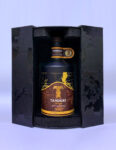
Limited-Edition Tanduay Heritage Rum Celebrates Brand’s Tradition of Excellence

McDonald’s PH Levels Up Their Best-Ever Burger Experience With Exciting New Dishes!
Related stories.

- People Food & Places

- Dine Philippines
Ginto Capitalizes on Gin Market’s Growth
You may have missed.
- Bahasa Indonesia
- Slovenščina
- Science & Tech
- Russian Kitchen
Cruising the Moskva River: A short guide to boat trips in Russia’s capital

There’s hardly a better way to absorb Moscow’s atmosphere than on a ship sailing up and down the Moskva River. While complicated ticketing, loud music and chilling winds might dampen the anticipated fun, this checklist will help you to enjoy the scenic views and not fall into common tourist traps.
How to find the right boat?
There are plenty of boats and selecting the right one might be challenging. The size of the boat should be your main criteria.
Plenty of small boats cruise the Moskva River, and the most vivid one is this yellow Lay’s-branded boat. Everyone who has ever visited Moscow probably has seen it.

This option might leave a passenger disembarking partially deaf as the merciless Russian pop music blasts onboard. A free spirit, however, will find partying on such a vessel to be an unforgettable and authentic experience that’s almost a metaphor for life in modern Russia: too loud, and sometimes too welcoming. Tickets start at $13 (800 rubles) per person.
Bigger boats offer smoother sailing and tend to attract foreign visitors because of their distinct Soviet aura. Indeed, many of the older vessels must have seen better days. They are still afloat, however, and getting aboard is a unique ‘cultural’ experience. Sometimes the crew might offer lunch or dinner to passengers, but this option must be purchased with the ticket. Here is one such option offering dinner for $24 (1,490 rubles).

If you want to travel in style, consider Flotilla Radisson. These large, modern vessels are quite posh, with a cozy restaurant and an attentive crew at your service. Even though the selection of wines and food is modest, these vessels are still much better than other boats.

Surprisingly, the luxurious boats are priced rather modestly, and a single ticket goes for $17-$32 (1,100-2,000 rubles); also expect a reasonable restaurant bill on top.
How to buy tickets?
Women holding photos of ships promise huge discounts to “the young and beautiful,” and give personal invitations for river tours. They sound and look nice, but there’s a small catch: their ticket prices are usually more than those purchased online.
“We bought tickets from street hawkers for 900 rubles each, only to later discover that the other passengers bought their tickets twice as cheap!” wrote (in Russian) a disappointed Rostislav on a travel company website.
Nevertheless, buying from street hawkers has one considerable advantage: they personally escort you to the vessel so that you don’t waste time looking for the boat on your own.

Prices start at $13 (800 rubles) for one ride, and for an additional $6.5 (400 rubles) you can purchase an unlimited number of tours on the same boat on any given day.
Flotilla Radisson has official ticket offices at Gorky Park and Hotel Ukraine, but they’re often sold out.
Buying online is an option that might save some cash. Websites such as this offer considerable discounts for tickets sold online. On a busy Friday night an online purchase might be the only chance to get a ticket on a Flotilla Radisson boat.
This website (in Russian) offers multiple options for short river cruises in and around the city center, including offbeat options such as ‘disco cruises’ and ‘children cruises.’ This other website sells tickets online, but doesn’t have an English version. The interface is intuitive, however.
Buying tickets online has its bad points, however. The most common is confusing which pier you should go to and missing your river tour.

“I once bought tickets online to save with the discount that the website offered,” said Igor Shvarkin from Moscow. “The pier was initially marked as ‘Park Kultury,’ but when I arrived it wasn’t easy to find my boat because there were too many there. My guests had to walk a considerable distance before I finally found the vessel that accepted my tickets purchased online,” said the man.
There are two main boarding piers in the city center: Hotel Ukraine and Park Kultury . Always take note of your particular berth when buying tickets online.
Where to sit onboard?
Even on a warm day, the headwind might be chilly for passengers on deck. Make sure you have warm clothes, or that the crew has blankets ready upon request.
The glass-encased hold makes the tour much more comfortable, but not at the expense of having an enjoyable experience.

Getting off the boat requires preparation as well. Ideally, you should be able to disembark on any pier along the way. In reality, passengers never know where the boat’s captain will make the next stop. Street hawkers often tell passengers in advance where they’ll be able to disembark. If you buy tickets online then you’ll have to research it yourself.
There’s a chance that the captain won’t make any stops at all and will take you back to where the tour began, which is the case with Flotilla Radisson. The safest option is to automatically expect that you’ll return to the pier where you started.
If using any of Russia Beyond's content, partly or in full, always provide an active hyperlink to the original material.
to our newsletter!
Get the week's best stories straight to your inbox
- What to do in Moscow City, if you’re not mega-rich
- Moscow after dusk: 10 places to drink, dance, and groove
- 5 things you must do in Moscow in 2018 between football matches (or without them)
- Sandwiched between Moscow and St. Petersburg: How to spend a perfect weekend in Tver
- 24 or 48 hours in Moscow: Where to go and what to do in 2019
This website uses cookies. Click here to find out more.

IMAGES
VIDEO
COMMENTS
Mar 4, 2024. Original: Apr 13, 2017. Although still in development, the Beneteau Figaro 3 represents the cutting edge of production foiing monohull design. Image Courtesy of Beneteau. Examining Vendée Globe boats on the dock in Les Sables d'Olonne prior to the start of the race last November, one thing was perfectly clear: the genie is out ...
The Figaro BENETEAU 3 is the first production foiling one-design monohull ever created.It is a distillation of technology and innovation, the result of a collaboration between some of BENETEAU's best experts and the Van Peteghem Lauriot-Prévost (VPLP) office, the architects of the last two boats to win the Vendée Globe.. The prototype has been tested and the production of the boat has been ...
Shortly after her re-launch at Easter, it was clear that the team had raised the game. "We can now foil upwind in just 8 knots of breeze," said Monnin. "And when the breeze builds to 12 ...
Future-E is not the only foiling yacht on the horizon. There have been myriad concepts surfacing recently, ... There was even a foiling monohull that competed in the 2021 America's Cup.
Look back to last December's Sydney-Hobart race, and remember how the 10-year-old maxi Wild Oats XI trounced the brand new Comanche, the world's most technically advanced—and probably most expensive—racing yacht.The Australian boat had just been fitted with its DSS foil, which tracks athwartships in a cassette below the waterline and is deployed to leeward.
The Persico Fly40 is aimed at yacht owners who are interested in taking part in a high-profile regatta circuit at the helm of a one-design monohull foiler that is derived directly from the experience and technology of the AC75s in last America's Cup. The Persico Fly40 is a " flying " one-design monohull with a speed of over 40 knots.
So if an Open 60 would struggle to get up, the prospect for other large foiling monohull keelboats is looking doubtful. SYZ&Co cants its daggerboards to vary the amount of side force and vertical lift
This 207-Foot Explorer Yacht Concept Has Its Own Pop-Up Observatory. ... The AC75 foiling monohull was the raceboat used in the 2018 America's Cup and will be the one-design of the next event.
Foils on Monohull Yachts. From IMOCA 60, to DSS or a variety of novel foil configurations, Clay helps teams, designers and owners to conceive, develop, problem-solve and optimise their foils. He has developed new methods to predict performance for an arbitrary foil shape and configuration to determine the performance potential of retro-fitting ...
A wide platform screams form stability and with two daggerboards and two rudders, controlling lift and righting moment is easy compared to balancing on a single main foil in a monohull. The consequences of falling off the foils are also usually far less severe, with a typically soft crash dampened by two or three hulls versus a capsize aboard a ...
Foiling in the Monohull Stream. ... An interesting fact taken from the Infiniti 46 is that while the displacement of the yacht is 5,500kg, the foil exits are engineered for 9,500kg of load ...
McConaghy Boats has started selling the AC40, a scaled-down version of the foiling monohull sailing yacht that competes in the America's Cup. The sleek boat will allow you and a crew of three ...
Te Rehutai. Te Rehutai is the AC75 foiling monohull yacht that Emirates Team New Zealand used to successfully defend the America's Cup for the Royal New Zealand Yacht Squadron in March 2021. [1] It beat the winner of the 2021 Prada Cup, Luna Rossa Prada Pirelli, representing Circolo della Vela Sicilia of Italy, 7-3 in a first to seven series ...
The British America's Cup team has become the fourth challengers to unveil their new AC75. INEOS Britannia revealed their AC75 in the early hours of morning, as the foiling monohull…
The Defender Emirates Team New Zealand and the Challenger of Record Luna Rossa have revealed the first details of the design for the AC75 foiling monohull that will race in the 36th America's Cup.. Challengers heading to Auckland in 2021 will have to master the art of sailing with twin canting T-foils, which can be lifted out of the water on the windward side to reduce drag.
November 23, 2017. 4 mins read. The concept of the AC75, the class of high-performance monohull racing yachts to be sailed in the 36th America's Cup, has finally been revealed. Compared with the previous editions managed by Alinghi and Oracle teams, this new concept marks an exciting new era in America's Cup racing.
About the 69F. Persico 69F is a mono-hull foiling sailboat designed by the Argentinian firm Wilson-Marquinez to offer to the widest possible sailing public a small foiler, using a concept borrowed from the AC75, the new boat for the 36th America's Cup. The prototype has already sailed for numerous days on Lake Garda, where it has been tested ...
Patriot in flight, but out of control and starting to capsize, 16 Jan 2021. Source: America's Cup video screenshot. The AC75 operates with two completely different sets of boat dynamics: Waterborne while accelerating at maximum power to quickly reach foiling speed at 12 - 14 knots. Flying on the foils to reach a top speed that can exceed 50 ...
CNN —. It's been developed in secret in Switzerland, but a new "flying" yacht could be a taste of things to come for the America's Cup. The Gonet Monofoil is a revolutionary monohull ...
Hydrofoiling wingsail catamaran 17. A sailing hydrofoil, hydrofoil sailboat, or hydrosail is a sailboat with wing-like foils mounted under the hull.As the craft increases its speed the hydrofoils lift the hull up and out of the water, greatly reducing wetted area, resulting in decreased drag and increased speed. A sailing hydrofoil can achieve speeds exceeding double and in some cases triple ...
Overhead view of the all-electric 10.5-meter Maserati Folgore Tridente luxury watercraft. Not the ... [+] first Maserati to take to the sea, sailing yachts monohull Maserati Mono 470 in 2012 and ...
More than 300 charter brokers attended the event on Poros. Credit: Greek Reporter 105 commercial yachts participated in the show on Poros. In its 20th year, the East Med Yacht Show included 105 Commercial Yachts moored at Poros port out of which 65 Catamarans, 30 motor yachts, 5 motor Sailers and Monohull Sailing yachts and 40 exhibitors were registered such as Greek crewed yacht charter ...
The new AC75 will be a fully flying monohull. Instead of a keel, it has two canting, ballasted T-foils to provide righting moment and the ability to self-right the boat in the event of a capsize ...
The Manila Yacht Club only welcomes visitors who arrive by boat, and it charges an initial security deposit of USD 750 upon arrival. Club membership is mandatory for medium and long-term mooring of boats. Subic Bay Yacht Club, Zambales. The Subic Bay Yacht Club, which was founded in 1998, upholds itself as the country's premier yacht club.
Surprisingly, the luxurious boats are priced rather modestly, and a single ticket goes for $17-$32 (1,100-2,000 rubles); also expect a reasonable restaurant bill on top.